
POR Number: 056-08
Contract Number: G9178-070030/003/CY
Award Date: 2009-01-28
Fieldwork Completion Date: 2009-03-04
FINAL REPORT
Ce rapport est disponible dans l’autre langue officielle.
March 2009
Phoenix Strategic Perspectives Inc.
1678 Bank Street, Ste. 2, Ottawa, Ontario K1V 7Y6
Tel: (613) 260-1700 Fax: (613) 260-1300
Email: info@phoenixspi.ca
www.phoenixspi.ca
Phoenix SPI was commissioned by Human Resources and Skills Development Canada (HRSDC) to conduct a survey with Canadians, 18 years and older, to explore issues related to the Employment Insurance (EI) Program. This study, which tracks data from similar surveys conducted from 1998 to 2008, was undertaken in order to explore public perceptions of the EI program and related matters. The telephone survey was completed by 1,515 respondents between February 14 and March 4, 2009. Based on a sample of this size and structure, the overall results can be considered to be accurate to within +/- 2.7%, 19 times out of 20.
Overview of Key FindingsWhile Canadians are currently pessimistic about the direction of the economy at all levels (i.e. national, provincial, and local), their confidence in maintaining employment remains high. They are also generally confident that the EI program will be there for them should they need it, and most feel that the benefits it provides are sufficient. Perceptions of the EI program are generally favourable, but awareness of the various elements and aspects of the program is sometimes low. This includes awareness of the newly created Canada Employment Insurance Financing Board (CEIFB) and of various measures undertaken by the government through the February 2009 Budget to enhance EI and provide additional funding for skills development and training. Despite limited awareness of the CEIFB, the vast majority acknowledge the importance of keeping a reserve in the CEIFB.
Key FindingsEconomic Perceptions
A majority of Canadians believe that the economy is weakening at the national (77%), provincial (71%) and local level (54%). The proportion who think the national economy is weakening has increased significantly compared to one year ago (77% vs. 28% in 2008), and is the highest it has been since tracking of this issue began. Despite this, a strong majority of employed and self-employed respondents (81%) think it is unlikely that they will lose their jobs in the coming year.
That said, for the first time since tracking began, fewer than half the employed respondents are categorical about their job security (i.e. that they are not at all likely to lose their job). It is also the first time since tracking began that fewer than half the currently employed Canadians who think they may lose their job in the next year believe they would be likely to find comparable or better employment in the next 12 months (32%).
Attitudes/knowledge of EI Program
Most employed respondents are confident they could access EI benefits if they were to lose their jobs (71%). One-third of respondents believe the EI program is being abused by seasonal workers, the lowest proportion since tracking of this issue began.
Just under half (47%) feel the EI program is fair, with the rest equally divided between neutrality and the perception that it is unfair (24% each). Those who described the EI program as unfair most often pointed to eligibility rules to explain why (25%). Almost half (48%) think the level of income support provided by the EI program is adequate, with an additional 5% describing it as generous, while 40% think it is insufficient.
A majority of Canadians said that the current EI program works well and needs only minor adjustments as problems arise (54%). However, over one-third (37%) see a need for major reforms. Those who think the EI program would benefit from changes were most likely to say that the level of benefits should be increased (21%). The large majority of Canadians (84%) would prefer to have a choice between receiving a higher amount of EI benefits over fewer weeks or a lower amount of benefits over a longer period of time.
Just over half of Canadians (52%) said they were not at all aware that additional benefits were available through the EI program for low-income families with children. Almost half of those who work for an employer indicated that they are very (30%) or somewhat aware (19%) of short-term illness benefits available through the EI program, while 41% said they were not at all aware of this, and 10% said they were not very aware of it.
Compassionate Care Benefits
Just under half of Canadians (49%) said they were somewhat or very aware of income benefits available to individuals who need to take time off work to care for a gravely ill or dying family member. Of the rest, 42% were not at all aware, while 9% were not very aware of the availability of such benefits. Of those who did not use Compassionate Care benefits during their time away from work to care for a gravely ill or dying person, well over half (62%) said they did not use them because they did not know about them. Over half of Canadians (55%) said they would be very likely to apply for Compassionate Care benefits if they were faced with a situation in which the need for such benefits arose. Another quarter said they would be somewhat likely to do so.
Interest of Self-Employed in Benefits
As has been the case in previous years, the survey findings show that a majority of self-employed Canadians (62-86%) are interested in benefits similar to those available to employees. Moreover, among those who say they are interested, two-thirds say they are willing to pay for a benefits package similar to the one currently available under the EI program.
Program Financing
Almost equal proportions of respondents think that EI premiums paid by Canadians have gone up over the past five years (32%) or stayed the same (33%). Nearly all the rest (29%) did not provide a response.
New Initiatives
The vast majority of Canadians (91%) are unaware of the creation of the Canada Employment Insurance Financing Board (CEIFB). Despite limited awareness of the CEIFB, the vast majority consider it very important (59%) or somewhat important (31%) that the federal government makes provisions to keep a reserve in the CEIFB.
A majority of Canadians (65-79%) were also unaware of various measures undertaken by the government through the February 2009 Budget to enhance Employment Insurance and provide additional funding for skills development and training.
More Information:
Supplier Name: Phoenix Strategic Perspectives Inc.
PWGSC Contract Number: G9178-070030/003/CY
Award Date: 2009-01-28
Human Resources and Skills Development Canada (HRSDC) commissioned Phoenix Strategic Perspectives to conduct a survey among the general public on issues related to the Employment Insurance program.
BackgroundThe Department has conducted a survey exploring public perceptions of the Employment Insurance (EI) program and related issues on an almost annual basis for the last 11 years. Given the changing nature of work occurring in the Canadian labour market, there is a need to continue annual tracking of public attitudes on various aspects and elements of the EI program to ensure the program remains responsive to the needs of workers. The annual nature of the survey allows for longitudinal insight to help identify emerging policy issues by tracking incremental changes in the perspectives of Canadians.
The tracking of EI issues has been an ongoing HRSDC research activity since 1998. The survey was last conducted in January-February 2008 using a regionally-stratified probability sample of 1,511 Canadians. The January 2007 survey also used a regionally-stratified probability sample of 1,500 Canadians. The March 2005 survey used a sample of 1,752 adult Canadians, including an over-sample of 426 Canadians who have been in a situation where the demands of their jobs were in conflict with the need to provide care for a gravely ill family member. Previously, surveys of 1,500 adult Canadians were conducted in January 2001 and December 2001. In 2003, the EI tracking survey was conducted among 1,500 adult Canadians, with an over-sample of 200 self-employed workers. In 2004, the survey was conducted among 1,500 adult Canadians in March, followed by a sample of 1,652 self-employed workers in April.
The objectives of the 2009 EI Tracking Survey include:
Results of the current survey will be used by EI Policy as part of its ongoing monitoring of the program, as well as for communications purposes. In addition, the survey results may provide direction for future research on EI program elements and other related issues.
Research DesignTo address the research objectives, a telephone survey was conducted among 1,515 Canadian residents, aged 18 years and over. The national findings based on the sample used in this study are accurate to within ± 2.7%, 19 times out of 20. The fieldwork for this study took place February 14 to March 4, 2009.
A disproportionately stratified sample was used in order to improve the accuracy of regional and provincial results. The survey sample frame is presented in the table below:
| Area | Sample Frame | |
|---|---|---|
| # of Interviews | Margin of Error | |
| Atlantic Provinces | 200 | +/- 6,9 |
| Quebec | 351 | +/- 5,2 |
| Ontario | 405 | +/- 4,9 |
| Prairie Provinces | 358 | +/- 5,6 * |
| Manitoba | 102 | +/- 9,7 |
| Saskatchewan | 103 | +/- 9,7 |
| Alberta | 153 | +/- 7,9 |
| British Columbia | 201 | +/- 6,9 |
| Canada | 1 515 | +/- 2,7 * |
* Note: The margin of error on findings for Canada and the Prairies region has been adjusted to take into account sample stratification.
Before undergoing analysis, the survey results were weighted to ensure that they accurately reflect the actual distribution of Canadians across the country and to allow the data to be treated as a regionally proportional random sample. Statistics Canada data were used to develop the weighting scheme to bring the results in line with the national distribution of Canadians. For the Prairie region, the component provinces were first weighted internally, and then the region was weighted with other provinces as an aggregate. This was done to ensure that when the region is looked at as a whole, the findings accurately reflect the geographic distribution of Canadians within that region. The survey data were also weighted by gender and age.
The following table presents information about the call disposition for this survey, as well as the response rate calculation (using the MRIA formula):
| Call Disposition Information | ||
|---|---|---|
| Total Numbers Accepted |
|
22028 |
| Total out of scope | 3 592 | |
| Numbers not in service | 3 481 |
|
| Business, non-residential | 94 |
|
| Duplicates | 0 |
|
| Blocked by telephone company | 17 |
|
| Unresolved |
|
7 722 |
| Busy, no answers, answering machines | 7 722 |
|
| Retired, called 8 times without success | 0 |
|
| In-scope Non-responding |
|
8 687 |
| Unavailable | 1 022 |
|
| Household refusal | 7 600 |
|
| Break offs | 65 |
|
| In-scope Responding units |
|
2 027 |
| Completes | 1 515 |
|
| Ineligible | 71 |
|
| Quota filled | 0 |
|
| Language disqualified | 441 |
|
| Response Rate | 10 % | |
Note to Reader
Throughout this report, the terms ‘respondents’ and ‘Canadians’ are used interchangeably to designate survey participants.
Appended to this report are copies of the questionnaire in English and French.
Majority Believe Economy Weakening at all Levels
A majority of Canadians believe that the economy at all levels (i.e. local, provincial, and national) is weakening. This pessimistic assessment is most widespread regarding the national economy (77%) and provincial economies (71%), while just over half (54%) have the same outlook for their local economies. Nearly all those whose outlook is not pessimistic indicated that the economy, at each of these levels, is staying about the same. Very few (2-4%) felt that the economy is strengthening at any level.

(Graph Description)
The above bar graph shows the economic perceptions at this point in time. The results are as follows:
Significant Increase in Pessimism Regarding Canadian Economy
The impact of the current economic downturn on perceptions of the Canadian economy is reflected in the accompanying tracking graph. The proportion who think the national economy is weakening has increased significantly compared to just one year ago (77% vs. 28% in 2008), and is the highest it has been since tracking began. There has been a corresponding sharp downturn in the proportions who think the economy is stable or getting stronger.

(Graph Description)
The above line graph shows the perceptions of the national economy, for the surveys conducted between 2001 and 2009. The results are as follows:
A strong majority (81%) of employed and self-employed respondents 1(n = 871) think it is unlikely that they will lose their job in the next year (with almost half describing this as not at all likely). Conversely, 15% viewed this as somewhat or very likely.
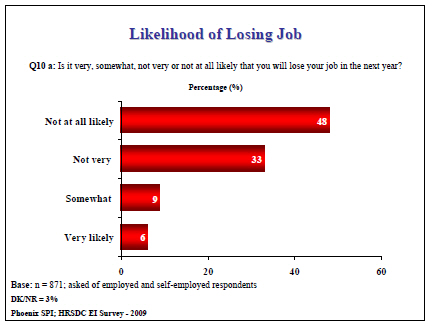
(Graph Description)
The above bar graph shows Canadians’ perceptions of the likelihood of losing their job in the coming year. The percentage value for each category is as follows:
1Please note that throughout the report the category "employed" refers to persons working for an employer, employed students, and persons on temporary leave, while the term "self-employed" refers to persons who are self-employed, as well as self-employed persons who are also working for an employer.
For the first time since tracking of this issue began, fewer than half the employed respondents are categorical about their job security (i.e. that they are not at all likely to lose their job). This halts the gradual increase between 2004 and 2008 in the proportion of respondents who think their job is secure.
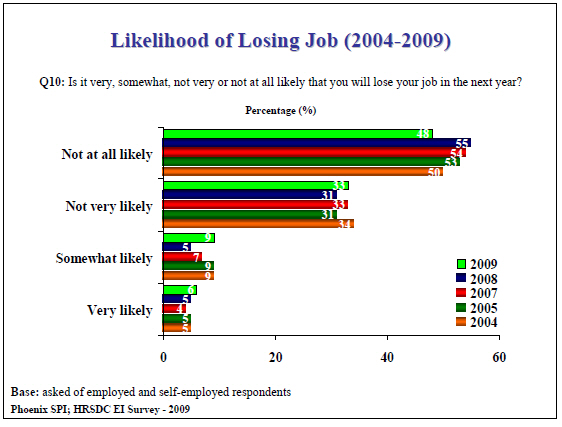
(Graph Description)
The above bar graph shows Canadians’ perceptions of the likelihood of losing their job in the coming year, for the surveys conducted between 2004 and 2009. The results are as follows:
Of those who think it at least somewhat likely that they will lose their jobs in the next year (n = 132), close to two-thirds (63%) think that if this were to happen, it would be within the next six months. One-third think it would be in the latter half of the next year.
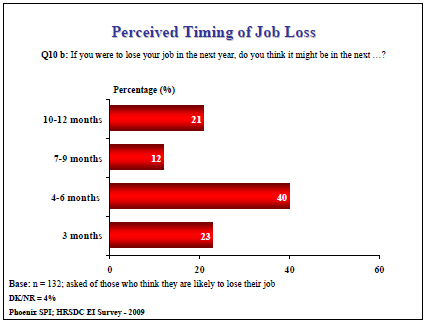
(Graph Description)
The above bar graph shows the perceived timing of job loss for those who think it at least somewhat likely that they will lose their jobs in the coming year. The percentage value for each category is as follows:
Fewer than half indicated that they would be at least somewhat likely to take any of these measures. Close to half (46%) said they would be willing to move to look for employment in their occupation in another location in Canada, if needed, with just over one-quarter (27%) saying this would be very likely. Approximately one-third (32-36%) indicated that they would be likely to undertake any of the other measures.

(Graph Description)
The above bar graph shows the likelihood of taking action in the event of a job loss for those who think it at least somewhat likely that they will lose their jobs in the coming year. The results are as follows:
Looked at another way, majorities said they were unlikely to take any of these measures. Approximately two-thirds said they would be unlikely to find a new job where they live, as good as or better than their current job within 12 months (67%), try to start their own business or become self-employed (65%), or move to seek employment in a different occupation in another location in Canada (63%). Just over half (53%) said they would be unlikely to move to seek employment in their occupation in another location in Canada.
2 Please note the relatively small base (n= 132) and exercise caution when interpreting these data.
Likelihood of Finding New Job in Same Location Hits Five-Year LowThe proportion that thinks it likely that they will find a new job where they live (should they lose their current job) is the lowest since tracking began in 2004, and the first time that fewer than half the respondents concerned indicated that this is likely (a drop of 23 percentage points compared to 2008). While the proportion that thinks this has been decreasing since 2005, the decline from year to year has been gradual compared to the drop this year.
On the other hand, there is little change in the perceived likelihood of moving to find employment in a different occupation, while there has been fluctuation in the perceived likelihood of moving in order to find employment in the same occupation (46% vs. 33% in 2008 and 45% in 2007). The question about the likelihood of trying to start their own business or become self-employed was not asked in previous waves.
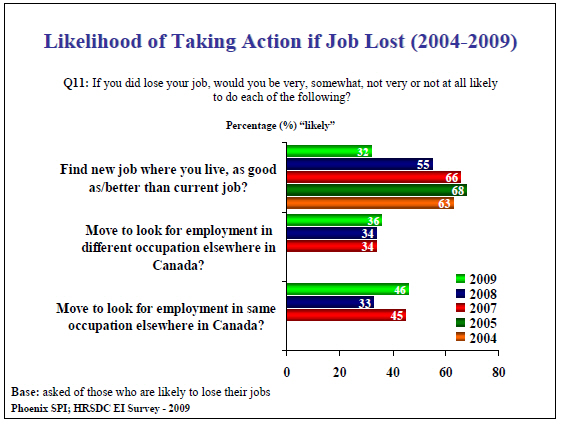
(Graph Description)
The above bar graph shows the likelihood of taking action in the event of a job loss for those who think it at least somewhat likely that they will lose their jobs in the coming year, for the surveys conducted between 2004 and 2009. The results are as follows:
This section explores respondents’ use, perceptions, and knowledge of the Employment Insurance program.
One-Quarter Have Received EI Benefits within Last Five YearsIn total, one-quarter of surveyed Canadians said they received EI benefits at some point in the last five years, while the rest have not. These results are virtually identical to results from 2008.
Of those who received benefits, 14% received them once in the past five years, 7% received them 2-3 times, and 4% received them 4 or more times.
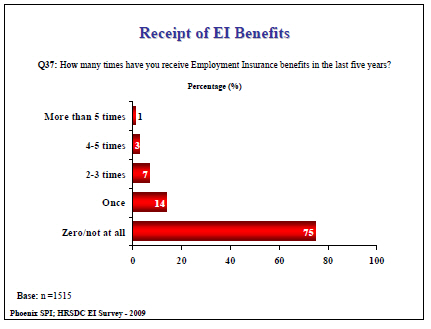
(Graph Description)
The above bar graph shows the frequency of receiving EI benefits in the last five years. The percentage value for each category is as follows:
Among those who received EI benefits in the last five years (n = 367), job loss was the reason cited most often (45%). This was followed, at a distance, by maternity leave (18%), illness (12%), seasonal work (10%), and lay-off/shortages of work due to the nature of employment (9%). Small numbers cited parental leave (5%), returning to school or an apprenticeship program (3%), and moving (2%). Included in the ‘other’ category are receiving compassionate care benefits, contract termination, injury/disability, and bankruptcy.
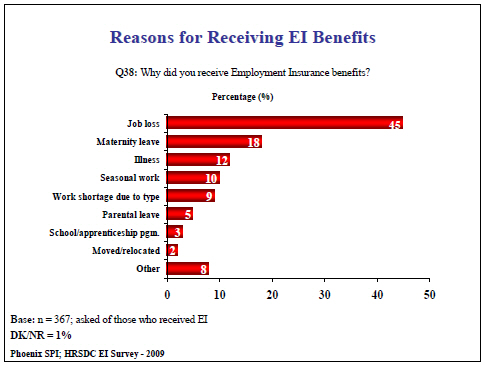
(Graph Description)
The above bar graph shows the reasons for receipt of EI benefits in the last five years. The percentage value for each category is as follows:
Job loss remains the most frequently identified reason for receiving EI benefits (45% vs. 42% in 2008).
Most Did Not Move to Find Work While Receiving EI BenefitsThe vast majority of those who received EI benefits within the last five years (87%) said they did not move to try to find work while receiving benefits. Conversely, 13% said they did.
Results are identical to those from 2008.

(Graph Description)
The above pie chart shows the percentage of Canadians who received EI benefits in the last five years and moved to find work. The percentage value for each portion is as follows:
Eighteen percent of respondents reported that someone else in their household received EI benefits during the last five years. Nearly all the rest (81%), said no one received these benefits, while 1% did not provide a response or said the question did not apply to them.
Results are identical to those from 2008.
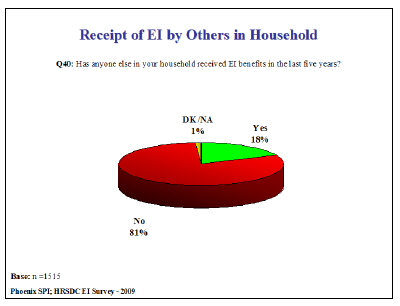
(Graph Description)
The above pie chart shows the percentage of receipt of EI by someone else in the household in the last five years. The percentage value for each portion is as follows:
Job loss also emerged as the most likely reason for others in the household receiving EI benefits. Forty-three percent of respondents who said someone else in their home had received EI benefits (n = 249) said it was because of job loss. Less common reasons, in declining order of frequency, include maternity leave (18%), illness (11%), seasonal work (10%), lay-off/shortage of work due to type of employment (9%), returning to school or an apprenticeship program (6%), parental leave (3%),and injury/disability (2%).
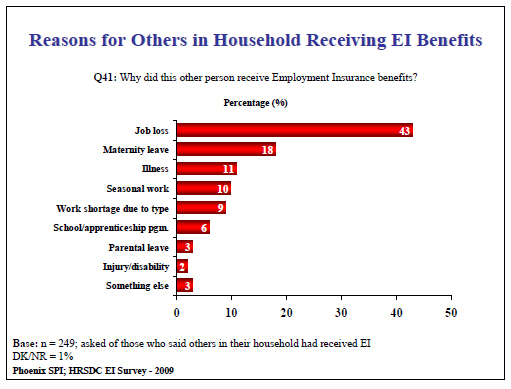
(Graph Description)
The above bar graph shows the reasons for others in the household to receive EI benefits in the last five years. The percentage value for each category is as follows:
Included in the ‘other’ category are bankruptcy, contract termination, and compassionate care benefits. Results are very similar those of 2008.
Perceptions of EI ProgramAmong employed respondents (n = 871), close to three-quarters (71%) agreed that they are confident they could access EI benefits if they were to lose their jobs (63% expressing strong agreement). Conversely, 17% disagreed, while 11% were neutral. Perceptions were mixed in reaction to the statement that too many people stay in seasonal jobs to collect benefits. Identical proportions (34% each) agreed and disagreed with this statement, while over one-quarter (29%) provided a neutral response.
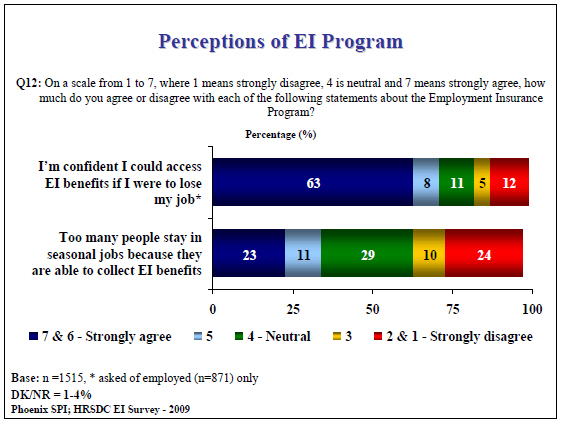
(Graph Description)
The above bar graph shows the perceptions of the EI Program. The results are as follows:
Over two-thirds of Canadians (68-74%) have expressed confidence in their ability to access EI benefits in each of the studies conducted since 2001. The level of strong confidence shows a marginal decrease compared to 2008, halting the slight gradual increase evident since 2005. That said, the level of strong confidence has varied by no more than 6 percentage points since tracking began (i.e. between 60% and 66%).
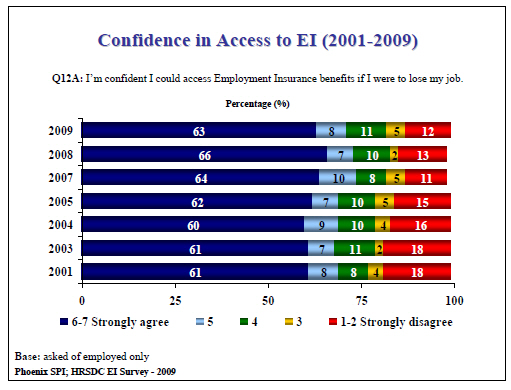
(Graph Description)
The above bar graph shows how polled individuals agreed with the statement: I’m confident I could access Employment Insurance benefits if I were to loose my job, for the surveys conducted between 2001 and 2009.
The results indicate that, since 2001, from 60 to 66 percent of individuals strongly agree with the above statement. The proportion of individuals who expressed that they strongly disagree ranged from 11 to 18 percent.
Perceptions of Abuse by Seasonal Workers Decline ModeratelyThere has been a gradual decline since 2007 in the proportion of Canadians who think that too many people stay in seasonal jobs because they are able to collect the benefits in the off-season (34% vs. 38% in 2008, and 42% in 2007). Moreover, the proportion that agrees with this is the lowest it has been since tracking began. The proportion that disagrees with this (34%) has not changed since 2004.
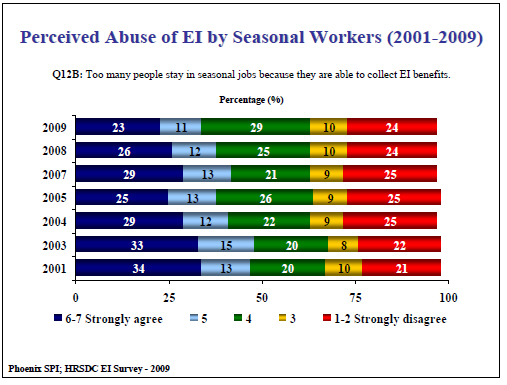
(Graph Description)
The above bar graph shows the perceived abuse of EI by seasonal workers, for the surveys conducted between 2001 and 2009.
The results indicate that the proportion who think too many people stay in seasonal jobs because they are able to collect EI benefits has been decreasing in the past three years to 23 percent in 2009. The proportion who are neutral on this question is the highest at 29 percent in 2009 since tracking began in 2001; this proportion has been increasing over the past three years. The proportion who strongly disagree with this statement has been relatively stable at 24 percent since 2004.
Close to Half Think EI Program is Fair, Rest DividedJust under half of respondents said they feel the EI program is somewhat (35%) or very fair (12%). The rest were equally divided between neutrality and the perception that the program is unfair (24% each).
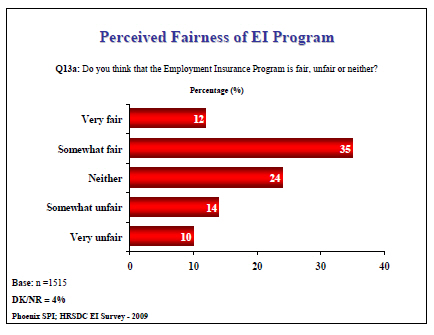
(Graph Description)
The above bar graph shows the perceived fairness of the EI program. The percentage value for each category is as follows:
The proportion of Canadians that thinks the EI program is fair has declined somewhat since 2007, from 51% to 47%. The proportion that perceives the EI program to be unfair has increased by 5% during this same period.
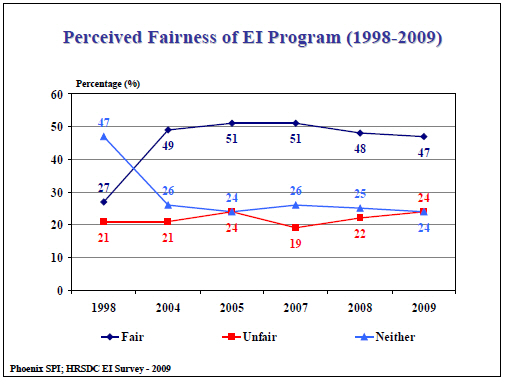
(Graph Description)
The above line graph shows the perceived fairness of the EI program for the surveys conducted between 1998 and 2009. The results are as follows:
Respondents who described the EI program as unfair (n = 388), most often pointed to eligibility rules to explain why (25%). This was followed by the two-week waiting period (15%), insufficient benefits (14%), the perception that some people have to pay premiums but cannot collect benefits (9%), the length of time during which one can receive benefits (8%), and the impression that the system is easy to abuse (6%).
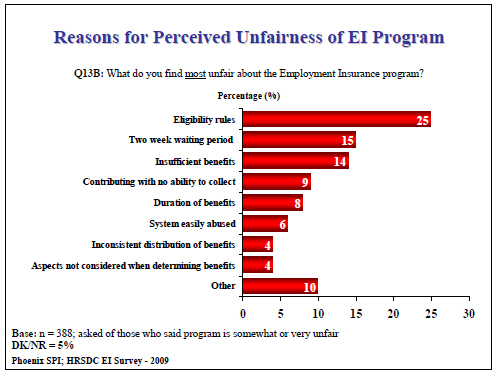
(Graph Description)
The above bar graph shows the reasons for the perceived unfairness of the EI Program. The percentage value for each category is as follows:
Small numbers identified inconsistent distribution of benefits across provinces, and considerations not taken into account when assessing claims. Included in the ‘other’ category are insufficient funding for training, no coverage for self-employed workers, the size of the surplus maintained, and determining benefits based on level of income.
Many Think Level of Income Support Provided by EI is AdequateAlmost half of those surveyed (48%) said the level of income support provided by the EI program is adequate, with an additional 5% describing it as generous. Most of the rest (40%) identified the level of income support as insufficient (40%), while 6% said they did not know or did not provide a response.
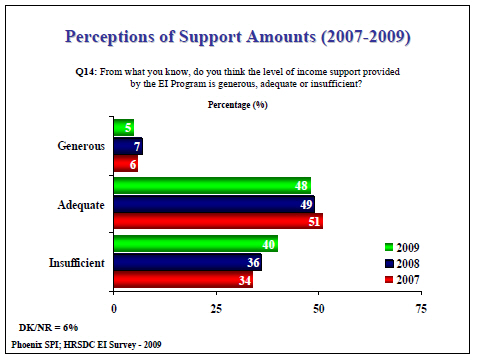
(Graph Description)
The above bar graph shows the perceptions of support amounts provided by the EI program, for the surveys conducted between 2007 and 2009. The results are as follows:
While perceptions have not changed much since 2007, there has been a slight but gradual decline in the number of Canadians who think the level of support is adequate (from 51% in 2007 to 48% in 2009), and a corresponding increase in the number who think the level of support is insufficient (from 34% in 2007 to 40% in 2009).
Just Over Half Unaware of Supplement for Low-Income FamiliesSlightly more than half of surveyed Canadians (52%) said they are not at all aware that additional benefits are available through the EI program for low-income families with children. A further 13% said they are not very aware of this. Those who claimed to be aware of this were more likely to describe themselves as somewhat aware (22%) than very aware (13%).
Awareness of Supplement for Low-Income Families Remains Low Over TimeThe proportion of those totally unaware of additional benefits provided by the EI program to low-income families with children has remained virtually unchanged since 2003 (50-52%). The proportion that is at least somewhat aware of this has also changed little since 2001 (31-35%).

(Graph Description)
The above bar graph shows the level of awareness that the EI Program provides additional benefits to low-income families who have children. The percentage value for each category is as follows:
The majority of respondents think that the current EI program works well and needs only minor adjustments as problems arise (54%). However, over one-third (37%) see a need for major reforms. Four percent said it needs neither.
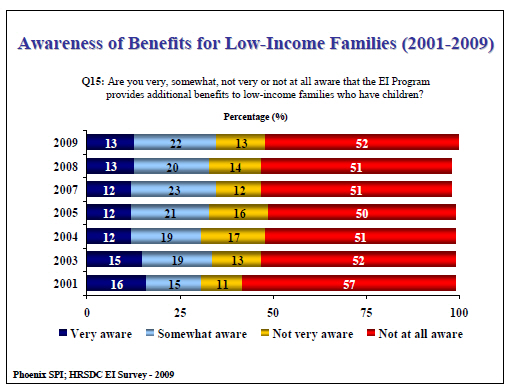
(Graph Description)
The above bar graph shows the level of awareness, for the surveys conducted between 2001 and 2009, that the EI Program provides additional benefits to low-income families who have children.
The results indicate that the proportions have been about constant for all the years of tracking. From the years 2001 to 2009, between 12 to 16 percent of polled individuals were very aware of benefits for low-income Canadians, 15 to 23 percent were somewhat unaware, 13 to 17 percent were not very aware and 50 to 57 percent were not at all aware.
Increase in Perceived Need for Reforms to EISince 2007 there has been an increase in the proportion of Canadians who feel the EI program requires major reforms (from 31% in 2007 to 37% in 2009). There has been a corresponding decrease in the proportion saying the program is working well and in need of only minor adjustments (from 61% in 2007 to 54% in 2009).

(Graph Description)
The above bar graph shows the perceived need for reform of the EI program. The percentage value for each category is as follows:
Since 2007 there has been an increase in the proportion of Canadians who feel the EI program requires major reforms (from 31% in 2007 to 37% in 2009). There has been a corresponding decrease in the proportion saying the program is working well and in need of only minor adjustments (from 61% in 2007 to 54% in 2009).
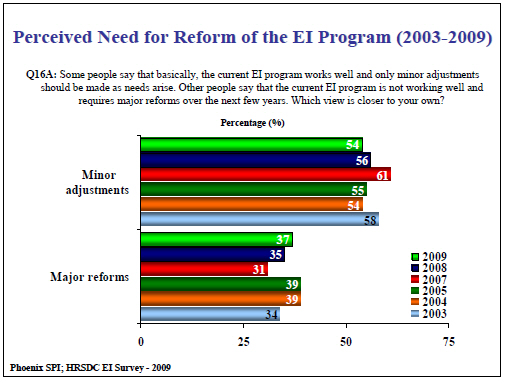
(Graph Description)
The above bar graph shows the perceived need for reform of the EI program for the surveys conducted between 2003 and 2009.
The results indicate that the proportion who think the EI Program needs only minor adjustments has been decreasing over the past three years and reached the same low level of 2004 (54 percent). This proportion was highest at 61 percent in 2007. The proportion who think the EI Program needs major reforms reached its second highest level in 2009. This proportion was 39 percent in 2004 and 2005, and 31 percent in 2007.
Increase Benefits, Expand Eligibility, Reduce Wait Times – Top Suggested Changes Respondents who think the EI program would benefit from changes were most likely to say that the level of benefits should be increased (21%), followed by expanding eligibility (14%) and reducing wait times (13%) (multiple responses accepted). Smaller and similar numbers see a need to crack down on abuse and restrict eligibility (7% each), increase the benefit period (6%), and provide help/incentives to get people back to work (5%).

(Graph Description)
The above bar graph shows the suggested changes to the EI program. The percentage value for each category is as follows:
Small numbers (2-4%) suggest more/better training and re-training programs, consistency in benefits across regions, taking other aspects into consideration when assessing claims, and ensuring benefit levels are proportionate to income level.
Included in the ‘other’ category are reviewing each claimant’s situation individually to better meet his/her needs, increasing the EI surplus, using part of the EI surplus to provide training, increasing the amount of maternal/parental leave benefits, increasing benefits for people who have lost their job, increase the amount of premiums paid by employers, and increasing benefits to seasonal workers.
One-quarter of these respondents (24%) said they do not know what changes should be made.
Top Suggestions Change Little Over TimeOverall, suggested adjustments have not changed much since 2005. Increasing the amount of benefits has increased slightly in importance, as has reducing wait times. Conversely, the likelihood of identifying eliminating abuse has declined (7% vs. 13% in previous waves).
2005 |
2007 |
2008 |
2009 |
|
|---|---|---|---|---|
| Increased benefits | 17 | 17 | 15 | 21 |
| Expand eligibility | 16 | 15 | 16 | 14 |
| Eliminate abuse | 13 | 13 | 13 | 7 |
| Reduce wait time | - | 8 | 8 | 13 |
| Better/more training & ed. programs | - | 8 | 7 | 4 |
| Provide back-to-work incentives | - | 8 | 7 | 5 |
| Ristrict eligilility | 10 | 6 | 6 | 7 |
| Assesments and adjustments* | - | 5 | 6 | - |
| Improve service | - | 5 | 3 | - |
| Reduce employee/employer premiums | - | - | 3 | - |
| Increase claim duration | - | - | 3 | 6 |
Base: asked of those who said program needs minor or major changes.
Phoenix SPI ; HRSDC EI Survey -2009
Most Would Prefer to Have Choice of Length and Amount of BenefitsThe large majority of Canadians (84%) would prefer to have a choice between receiving a higher amount of EI benefits over fewer weeks or a lower amount of benefits over a longer period of time. Twelve percent indicated that they did not feel such a choice was required, while 3% volunteered that in their opinion such a choice does not matter.
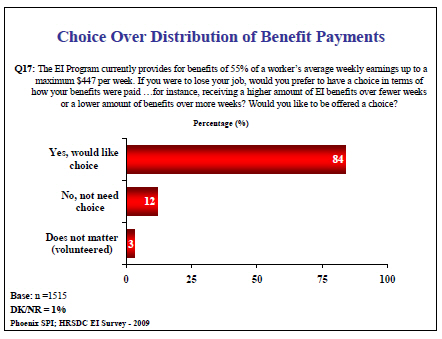
(Graph Description)
The above bar graph shows the choice over the distribution of benefit payments in the even of a job loss. The percentage value for each category is as follows:
Results have changed little since 2008.
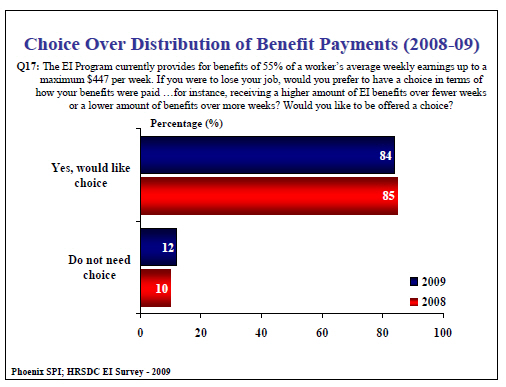
(Graph Description)
The above bar graph shows the choice over the distribution of benefit payments in the event of a job loss, for 2008 and 2009.
The results indicate that the proportion who would like a choice has remained relatively the same (85 percent in 2008 and 84 percent in 2009). The proportion who do not feel such a choice was required was also relatively the same, at 10 percent in 2008 and 12 percent in 2009.
Divided Views on Preferred Distribution of Benefit PaymentsRespondents were divided when it came to preferences regarding distribution of benefit payments. The largest proportion (47%) said that, if they were to lose their jobs and had a choice, they would rather receive a higher amount of benefits over fewer weeks. However, a substantial number (40%) indicated that they would rather receive a lower amount over more weeks. Among the rest, 7% volunteered that it would depend on their specific circumstances, while 3% volunteered that it made no difference how their benefits were paid out.
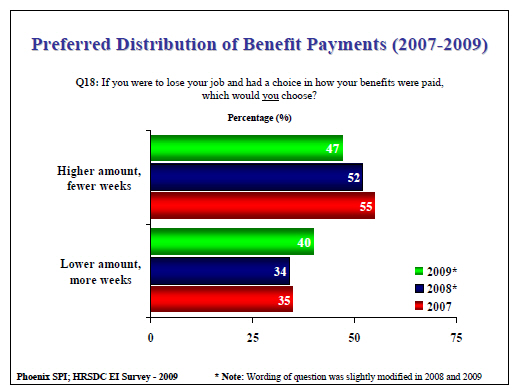
(Graph Description)
The above bar graph shows the preferred distribution of benefit payments in the event of a job loss, for the surveys conducted between 2007 and 2009. The results are as follows:
Since 2007, there has been a gradual decline in the proportion in favour of receiving a higher amount of benefits over fewer weeks. Indeed, for the first time since tracking began fewer than half expressed a preference for this option. Conversely, the proportion favouring a lower amount over more weeks has increased (40% vs. 34-35% in 2007-2008).
Half Have Limited Awareness of Short-Term Illness BenefitsThe largest proportion of respondents who work for an employer (41%) indicated that they have no awareness of short-term illness benefits available through the EI program, while an additional 10% said they have little awareness of such benefits. Conversely, 30% indicated that they are very aware of such benefits, and an additional 19% said they are somewhat aware of them.
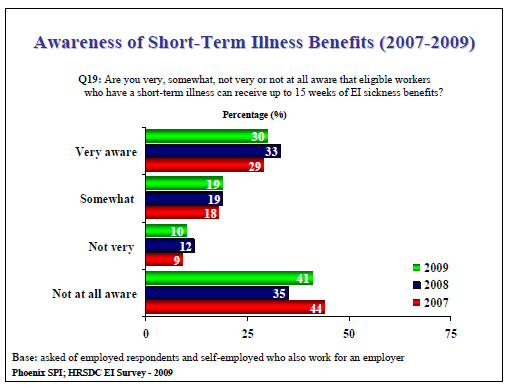
(Graph Description)
The above bar graph shows the level of awareness that eligible workers who have a short-term illness can receive up to 15 weeks of EI sickness benefits, for the surveys conducted between 2007 and 2009. The results are as follows:
Awareness of short-term illness benefits has fluctuated over the past few years (49% vs. 52% in 2008 and 47% in 2007).
This section presents respondent perceptions of issues related to Compassionate Care benefits.
Almost Half at Least Moderately Aware of Compassionate Care BenefitsAlmost half of surveyed Canadians (49%) said they are at least somewhat aware of income benefits available to individuals who need to take time off work to care for a gravely ill or dying family member. Of the rest, 42% said they are not at all aware of such benefits, and 9% said they are not very aware of them.

(Graph Description)
The above bar graph shows the level of awareness of Compassionate Care Benefits for Canadians who take time off work to care for or support a gravely-ill family member. The percentage value for each category is as follows:
While awareness of Compassionate Care benefits has not changed very much since 2004, this is the first time since tracking began that fewer than half of the respondents have claimed to be at least somewhat aware of them (49% vs. 51% in 2008, 52% in 2007, and 55% earlier).
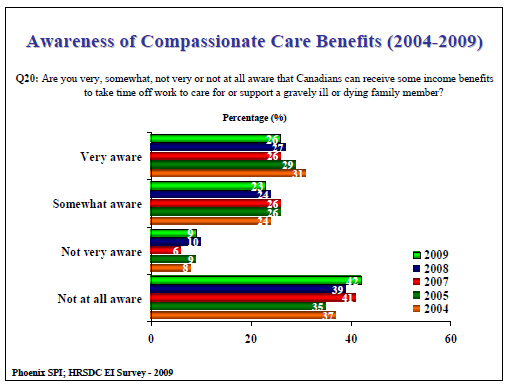
(Graph Description)
The above bar graph shows the level of awareness of Compassionate Care Benefits for Canadians who take time off work to care for or support a gravely-ill family member, for the surveys conducted between 2004 and 2009. The results are as follows:
The large majority of respondents have never been in a situation in which their job demands came into conflict with the need to provide care for a family member. Among those who have, this most often involved one-time medical emergencies (17%), followed by having to take care of someone with a chronic or long-term illness (14%), and being called upon to provide care or support for someone who was gravely ill or dying (13%).
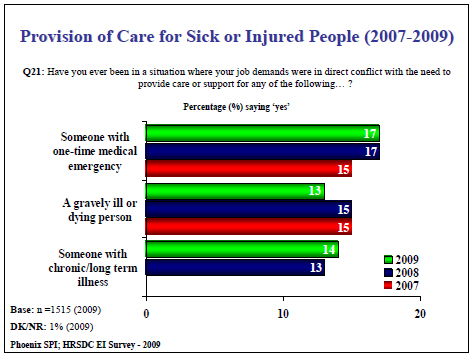
(Graph Description)
The above bar graph shows the proportion of Canadians whose job demands have ever been in direct conflict with their provision of care for sick or injured people, for the surveys conducted between 2007 and 2009. The results are as follows:
Results have changed little since 2007.
Most Took Time Off to Care for Ill or Dying PersonOf those who had experienced conflicts between job demands and the need to care for a very ill or dying person (n = 224), 70% said they took time off work to accommodate that need while 29% did not.
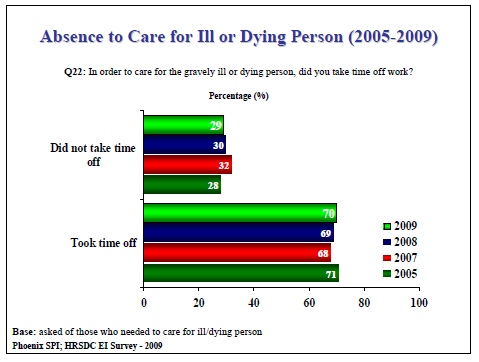
(Graph Description)
The above bar graph shows the absence to care for a gravely-ill or dying person, for the surveys conducted between 2005 and 2009.
The results indicate that the proportions were relatively the same for the last four years of tracking. Those who indicated that they did not take time off work ranged from 28 percent in 2005 to a high of 32 percent in 2007. This proportion was 29 percent in 2009. Those who indicated that they took time off work ranged from 68 percent in 2007 to 71 percent in 2005, this proportion was 70 percent in 2009.
The proportion of Canadians who reported taking time off work in order to care for a very ill or dying person has remained almost the same since tracking began in 2005 (i.e. between 68-71%).
Professionals or Institutions Provided Care if Respondents Did Not Take Time OffRespondents who have been in a situation where they needed to care for an ill or dying person but who did not take time off work (n = 61) were most likely to say that the ill person was cared for by professional caregivers (47%). This was followed by 34% who said that someone else took time off from their work to care for this person, 27% who said that an unemployed person provided care, and 15% who said someone working part-time provided care (multiple responses accepted).
Fourteen percent said they found time to care for this person even though they did not take time off work.
Tracking of this question over time is difficult due to the relatively low incidence of respondents who have found themselves in this situation. However, the data has been consistent insofar as care by a professional or through an institution is the most common solution found by those who did not take time off work for this (47% in 2009, 51% in 2008, 48% in 2007, and 58% in 2005).
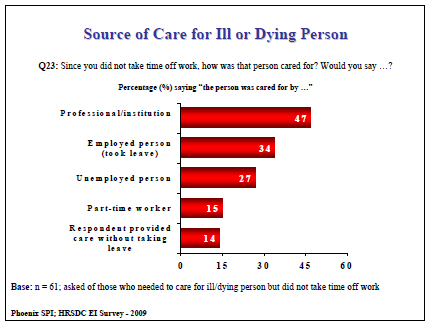
(Graph Description)
The above bar graph shows the sources of care for an ill/ dying person for Canadians who indicated they did not take time off work to care for an ill/ dying person. The percentage value for each category is as follows:
Among those who took time off to care for a gravely ill or dying person (n = 162), two- thirds took at least two weeks away from work (34% took 2-6 weeks, and 33% took 7 weeks or more). Over one-quarter (29%) took less than two weeks. Four percent volunteered that care is still ongoing.
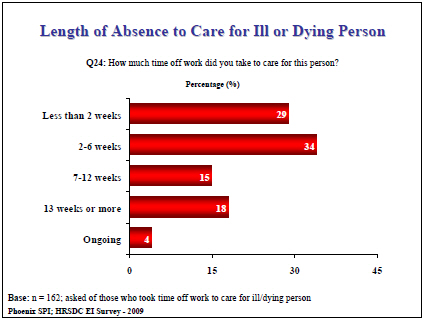
(Graph Description)
The above bar graph shows the length of absence to care for an ill /dying person for Canadians who indicated they took time off work to care for an ill /dying person. The percentage value for each category is as follows:
Given the relatively small number of respondents who faced such a situation, the accuracy of conclusions drawn from the tracking data is limited. However, data for the period between 2005 and 2008 indicates that most people who find themselves in this situation end up taking less than seven weeks off work.
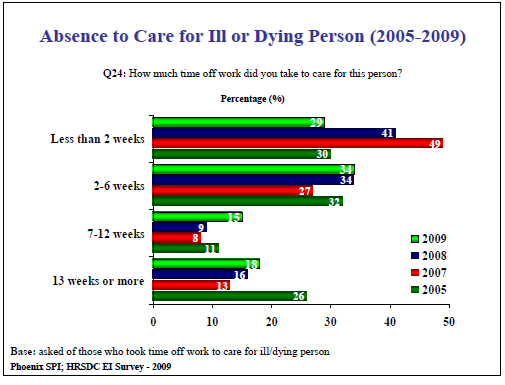
(Graph Description)
The above bar graph shows the length of absence to care for an ill /dying person for Canadians who indicated they took time off work to care for an ill /dying person, for the surveys conducted between 2005 and 2009. The results are as follows:
Fully 84% of those who took time off to care for an ill or dying person took some form of paid leave, including vacation time (35%), sick leave (19%) general leave with pay, or family leave (15% each) (multiple responses accepted).
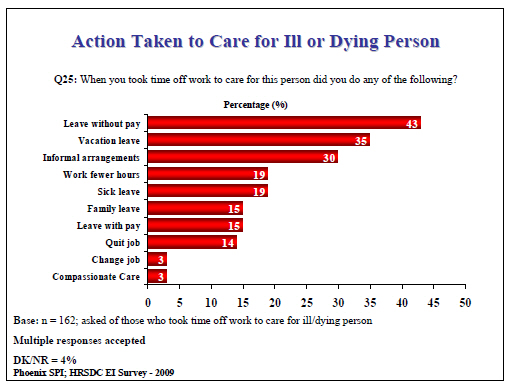
(Graph Description)
The above bar graph shows the action taken to care for an ill /dying person for Canadians who indicated they took time off work to care for an ill /dying person. The percentage value for each category is as follows:
Not surprisingly given the fact that most respondents’ absences from work were fairly short, the largest single proportion of those who did take time off took leave without pay (43%), while nearly one-third (30%) made informal arrangements with their employer. One in five (19%) worked fewer hours, while small numbers (3% each) changed their jobs or applied for and received Compassionate Care benefits under the EI program.
While there are a few differences in the likelihood of taking specific actions compared to 2008, the only one of note is the more than twofold increase in the likelihood of taking sick leave (19% vs. 8% in 2008).
| Action Taken | 2008 |
2009 |
|---|---|---|
| Leave without pay | 40 | 43 |
| Informal arragements | 37 | 30 |
| Vacation leave | 28 | 35 |
| Leave with pay | 21 | 15 |
| Work fewer hours | 18 | 19 |
| Family leave | 15 | 15 |
| Quit job | 12 | 14 |
| Seak leave | 8 | 19 |
| Cahnge job | 5 | 3 |
| Compassionate care | 5 | 3 |
Base : asked of those who took time off work to care for ill/dying person
Phoenix SPI ; HRSDC EI Survey -2009
Lack of Awareness – Main Reason for Not Using Compassionate Care BenefitsOf those who did not use Compassionate Care benefits during their time away from work to care for a gravely ill or dying person, well over half (62%) said they did not use them because they did not know about them. This was identified five times more often than any other reason. Other reasons include the fact that their situation occurred before such benefits were available (12%), the impression that the benefits were unnecessary (6%), the impression that these benefits would not arrive in time (4%), uncertainty about qualifying for these benefits (4%), and applying but being ineligible (4%).
| Arrangement | 2007 |
2008 |
2009 |
|---|---|---|---|
| Unware of benefits | 56 | 47 | 62 |
| happened before CC available | 17 | 19 | 12 |
| Unnecessary | 6 | 8 | 6 |
| Unsure would qualify | 6 | 8 | 4 |
| Tried, did not qualify | 2 | 4 | 4 |
| Would not arrive in time | 4 | 3 | 4 |
| Benefits inadequate | - | 2 | 1 |
| Employer not supportive | - | 2 | 1 |
Base : asked of those who did not use Compassionate Care benefits.
Phoenix SPI ; HRSDC EI Survey -2009
Very small numbers identified lack of EI coverage, lack of time to apply, benefits being inadequate, unsupportive employers, and that the person requiring care was not an eligible family member.
Lack of awareness of these benefits was more likely to be identified this year than in the past (62% vs. 47% in 2008 and 56% in 2007).
Over Three-Quarters Likely to Apply for Compassionate Care in Future if NeededOver half of surveyed Canadians (55%) said they would be very likely to apply for Compassionate Care benefits if they were faced with a situation in which the need for such benefits arose. Another quarter said they would be somewhat likely to do so. Of the rest, 9% each said they would be not very or not at all likely to apply for such benefits.
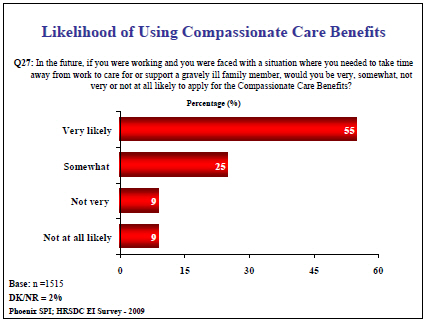
(Graph Description)
The above bar graph shows the likelihood of using Compassionate Care Benefits in the future if they were working and faced with a situation where they needed to take time away from work to care for or support a gravely-ill family member. The percentage value for each category is as follows:
The proportion of respondents saying they would be at least somewhat likely to do this has increased since last year and is more in line with what it had been since 2005 (80% vs. 75% in 2008, 81% in 2007, and 79% in 2005). As well, the proportion saying they would be very likely to do this is slightly higher than it was last year, and reverses a decline evident over the last couple of years (55% vs. 51% in 2008, 54% in 2007, and 56% in 2005).
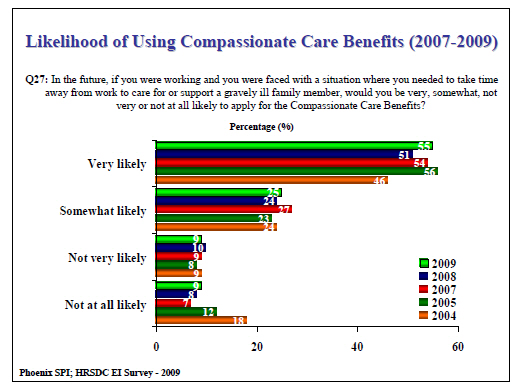
(Graph Description)
The above bar graph shows the likelihood of using Compassionate Care Benefits in the future if they were working and faced with a situation where they needed to take time away from work to care for or support a gravely-ill family member, for the surveys conducted between 2004 and 2009.
The results indicate that the proportions have been about constant for the last five years of tracking. From the years 2004 to 2009, from 46 to 55 percent of polled individuals said they were very likely to take compassionate care benefits if the need arose, 23 to 27 percent said they were somewhat likely to take the benefits, 8 to 10 percent said they were not very likely to benefits and 7 to 18 percent said they were not at all likely to take benefits.
Different Reasons for Not Applying in FutureRespondents who said they would not apply for Compassionate Care benefits in the future (n = 273) most often explained why by saying that the benefits are not necessary (15%), and that their employee benefits would provide sufficient coverage (13%). Ten percent said they are not working and therefore not paying EI so that this does not apply to them, and 9% said this is not financially necessary.
A host of reasons were identified by smaller numbers including the following: the impression that such benefits would be inadequate, being against the idea, and not wanting to take time off (6% each), being unsure they would qualify and being at retirement age (5% each), and the perception that it would be too much of a hassle (3%).
Very small numbers (2% or less) pointed to lack of detail about these benefits, the impression that they may have to be paid back, inability to take time off, the waiting time, and being self-employed. Some (4%) said there was no reason, while 3% said they did not know or did not provide a response.
The likelihood of saying that they do not pay EI as a reason for not applying is lower than in 2007 and 2008 (10% vs. 16% in 2008 and 2007). The likelihood of saying that they are against such benefits or that they are not financially necessary has fluctuated over time, while the likelihood of saying that it would be too much of a hassle has declined over time.
| Reason | 2007 |
2008 |
2009 |
|---|---|---|---|
| Do not pay EI | 16 | 16 | 10 |
| Not necessary | 13 | 16 | 15 |
| Employee benefits would cover* | 10 | 16 | 13 |
| Against it | 4 | 12 | 6 |
| Unsure would qualify | - | 10 | 5 |
| Too much hassle | 15 | 8 | 3 |
| $ not necessary | 10 | 3 | 9 |
| Could not take time off | 6 | 3 | 6 |
| Inadequate | 2 | 3 | 6 |
| Age/would retire | 2 | 2 | 5 |
| Family responsibility | 3 | - | - |
| No reason | 4 | 2 | 4 |
Base: asked of those who would not apply for Compassionate Care benefits
Phoenix SPI ; HRSDC EI Survey -2009
This section explores interest of the self-employed in EI-type benefits. Questions were asked only of self-employed respondents. As such, the questions in this section were asked of between 623 and 199 respondents.
Majorities Interested in All Benefits, But Mainly Sickness and Compassionate CareSelf-employed individuals were most likely to express interest in sickness (86%) and Compassionate Care benefits (84%), with majorities expressing strong interest in each. This was followed by interest in benefits in the event of business failure in which 74% expressed interest. Approximately two-thirds expressed interest in parental benefits (65%), and maternity benefits (62%). Disinterest in these types of benefits ranged from 9-31%, and was highest regarding maternity benefits (30%) and parental benefits (31%).
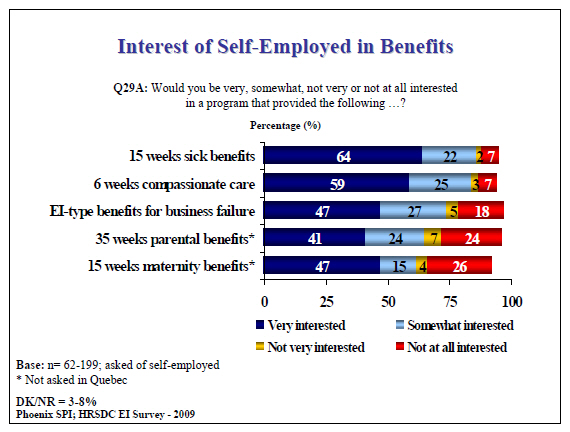
3 The questions about maternity and parental benefits were not asked in Quebec since such benefits are currently available in that province, while the question about maternity benefits was not asked to self-employed males.
(Graph Description)
The above bar graph shows the interest of self-employed individuals in benefits. The results are as follows:
Interest in all but one of these EI-type benefits has increased compared to 2008. This includes interest in benefits in case of business failure (74% vs. 67%), maternity benefits (62% vs. 56%), sickness benefits (86% vs. 80%), and compassionate care benefits (84% vs. 80%), However, caution should be exercised in interpreting the results in this area due to the relatively small sample size.
| Benefit | 2004 | 2005 | 2007 | 2008 | 2009 |
|---|---|---|---|---|---|
| Ei-type benefits for business failure | |||||
| Very interested (%) | 45 | 40 | 46 | 45 | 47 |
| Somewhat interested (%) | 23 | 23 | 26 | 22 | 27 |
| 35 weeks parental benefits | |||||
| Very interested (%) | 32 | 45 | 54 | 44 | 41 |
| Somewhat interested (%) | 24 | 24 | 19 | 21 | 24 |
| 6 weeks compassionate care | |||||
| Very interested (%) | 52 | 59 | 62 | 54 | 59 |
| Somewhat interested (%) | 26 | 22 | 21 | 26 | 25 |
| 15 weeks sick benefits | |||||
| Very interested (%) | 55 | 59 | 64 | 60 | 64 |
| Somewhat interested (%) | 23 | 22 | 20 | 20 | 22 |
| 15 weeks maternity benefits | |||||
| Very interested (%) | 32 | 42 | 44 | 38 | 47 |
| Somewhat interested (%) | 19 | 20 | 14 | 18 | 15 |
Base : asked of self-employed.
*Asked only to female self-employed workers in 2009
Phoenix SPI ; HRSDC EI Survey -2009
Among Those Interested, Most Willing to Pay Premiums for Benefits
Most self-employed respondents who expressed interest in each of the five types of benefits said they would be willing to pay EI premiums to become eligible to receive them. Willingness to pay was most widespread for sick benefits (85%) and compassionate care benefits (82%). Three-quarters were willing to pay for benefits for business failure and parental benefits, while 70% were willing to pay for maternity benefits.

(Graph Description)
The above bar graph shows the willingness of self-employed individuals who expressed interest in benefits to pay for those benefits, for the surveys conducted between 2007 and 2009. The results were stable with a relatively high proportion indicating they would be willing to pay EI premiums for the benefits. The details are as follows:
Willingness to pay for business failure benefits is lower than in previous waves (75% vs. 81% in 2008 and 2007). Conversely, interest in sickness benefits has increased since last year (85% vs. 79% in 2008), and interest in compassionate care benefits has been increasing since 2007 (70% in 2007 vs. 76% in 2008 and 82% in 2009). Interest in paying for parental benefits is virtually unchanged compared to last year, while interest in paying for maternity benefits is down slightly.
Two-Thirds Would Pay Same Premiums as Employed to Access BenefitsTwo-thirds of self-employed respondents said they would be willing to pay premiums equivalent to those that enable employees to receive EI benefits in order to access a package of maternity, parental, sickness, and Compassionate Care benefits if they were available. Just over one-quarter (27%) said they would not be willing to do so (7% did not provide a response).
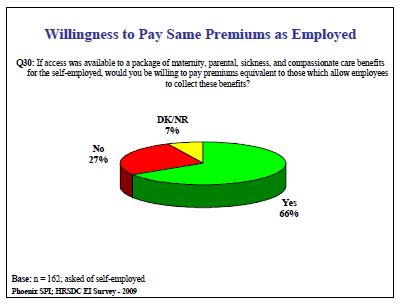
(Graph Description)
The above pie chart shows the willingness of self-employed individuals to pay EI premiums equivalent to those paid by employed Canadians for a package of maternity, parental, sickness, and compassionate care benefits. The percentage value for each portion is as follows:
The proportion of self-employed Canadians who said they would be willing to pay premiums equivalent to those allowing employees to collect benefits has remained steady (approximately two-thirds) since tracking began in 2005.
Most Could Take No More Than Three Months Away from WorkFully 80% of self-employed respondents said they could afford to take no more than three months away from work if they had access to an EI benefits package. This includes one-third who said they could take less than one month, 30% who could take between one and three months, and 17% who could not take off any time. Of the rest, 6% could take 4-6 months off and 5% could take 10-12 months.
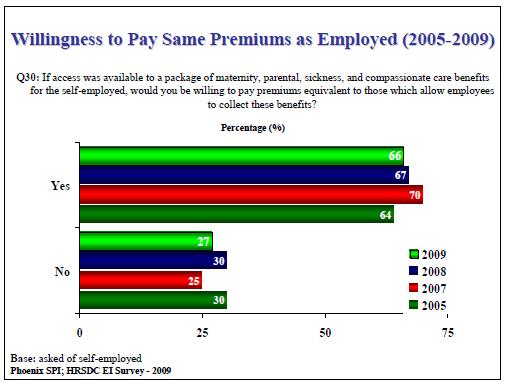
(Graph Description)
The above bar graph shows the willingness of self-employed individuals to pay EI premiums equivalent to those paid by employed individuals for a package of maternity, parental, sickness, and compassionate care benefits, for the surveys conducted between 2005 and 2009.
The proportions were stable over the years. The proportion of those who indicated they would be willing to pay for the same premiums ranged from a low of 64 percent in 2005 to a high of 70 percent in 2007. The proportion of those who indicated they would not be willing to pay for the same premiums ranged from a low of 25 percent in 2007 to a high of 30 percent in 2005 and 2008.
Most Could Take No More Than Three Months Away from WorkFully 80% of self-employed respondents said they could afford to take no more than three months away from work if they had access to an EI benefits package. This includes one-third who said they could take less than one month, 30% who could take between one and three months, and 17% who could not take off any time. Of the rest, 6% could take 4-6 months off and 5% could take 10-12 months.
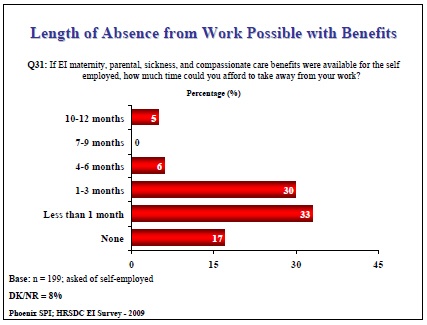
(Graph Description)
The above bar graph shows the length of absence from work possible with benefits for self-employed individuals if maternity, parental, sickness, and compassionate care benefits were available. The percentage value for each category is as follows:
Tracking of this question continues to show that should EI benefits become available to self-employed Canadians, the majority could take no more than three months off work, while among the rest, the largest portion (15-21%) could not take any time off at all.
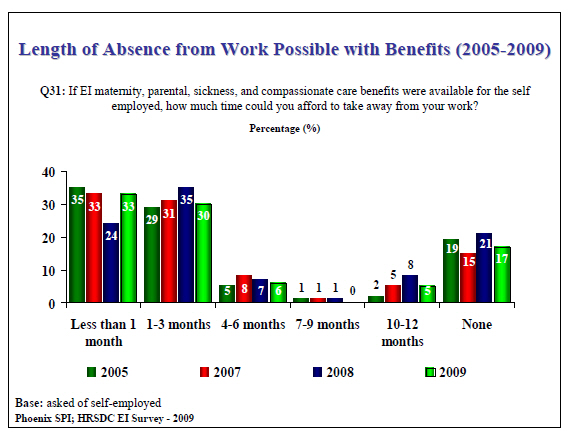
(Graph Description)
The above bar graph shows the length of absence from work possible with benefits for self-employed individuals if maternity, parental, sickness, and compassionate care benefits were available, for the surveys conducted between 2005 and 2009.
The proportions were relatively stable over the years. The results between 2005 and 2009 indicate that the vast majority of self-employed would take either no benefits or less than 3 months.
The question in this section was asked of all respondents and explores financing of the EI program.
Two-Thirds Think Premiums Have Increased or Stayed the SameMost respondents were almost equally split between thinking that EI premiums paid by Canadians have gone up over the past five years (32%) or stayed the same (33%). Only 6% think that these premiums have decreased. Over one-quarter (29%) did not provide a response.
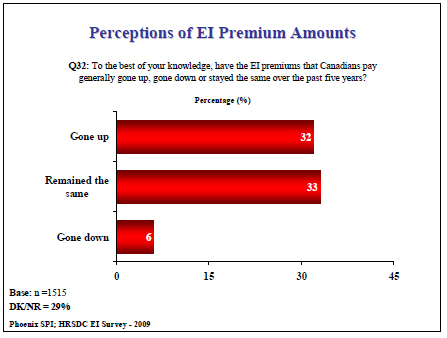
(Graph Description)
The above bar graph shows the perceptions of EI premium amounts. The percentage value for each category is as follow:
The proportion of Canadians that believes that EI premiums have increased has been declining since 2005, while the proportion believing they have remained the same has increased over the same period of time. The proportion that believes EI premiums have decreased has changed little since 2004 (6%-9%).

(Graph Description)
The above bar graph shows the perceptions of EI premium amounts, for the surveys conducted between 2001 and 2009. The results are as follow:
The section explores the awareness and perspectives of all respondents as they pertain to new initiatives related to the EI program.
Limited Awareness of CEIFBThe vast majority of respondents (91%) are not aware of the creation of the Canada Employment Insurance Financing Board (CEIFB). Those who said they are aware of the CEIFB were more likely to be vaguely aware (6%) than definitely aware (3%) of it. Respondents were informed that the CEIFB is designed to manage a reserve and implement a new mechanism to determine the premium rate for Employment Insurance.

(Graph Description)
The above pie chart shows the awareness of the Canada Employment Insurance Financing Board (CEIFB). The percentage value for each portion is as follows:
Despite limited awareness of the CEIFB, the large majority of respondents consider it very (59%) or somewhat important (31%) that the federal government make provisions to keep a reserve in the CEIFB.

(Graph Description)
The above bar graph shows how much consideration Canadians give to a reserve in the CEIFB. The percentage value for each category is as follows:
The level and degree of importance attributed to keeping a reserve for EI purposes has changed little compared to last year. In 2008, respondents were asked about this issue without any reference to the CEIFB, which had not been created at the time of the 2008 survey.
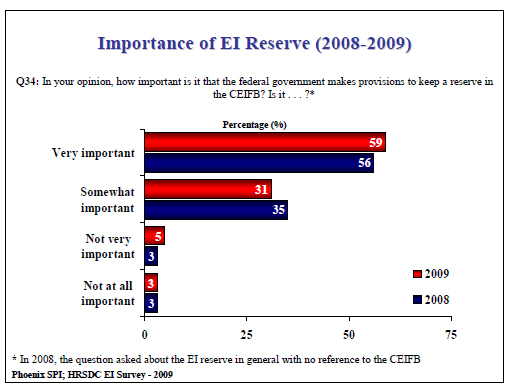
(Graph Description)
The above bar graph shows how much consideration Canadians give to EI reserve, for 2008 and 2009.
The results indicate that the relative importance Canadians give to EI reserve has changed little. In addition to the previous bar graph, this graph shows that the proportion of Canadians who consider an EI reserve very important has grown from its 2008 level of 56 percent, while the proportion who consider it somewhat important has decreased from its 2008 level of 35 percent. The proportion who consider it not very important has increased from its 2008 level of 3 percent, and the proportion who consider it not at all important has not changed.
Majority Confident That CEIFB Will Improve Management of EI FinancingWhile a majority of respondents (53%) are confident that these new measures will improve the management of the Employment Insurance program financing, they are much more likely to be moderately (45%) than very confident about this (8%). Among the rest, 30% are only a little confident and 13% are not confident at all.

(Graph Description)
The above bar graph shows the degree of confidence in new measures to manage the EI program financing. The percentage value for each category is as follows:
Looked at slightly differently, three-quarters of respondents have moderate or little confidence in these new measures. That said, this limited confidence should be interpreted in light of the widespread lack of awareness of the CEIFB.
Most Unaware of Measures to Enhance EI in February 2009 BudgetBetween two-thirds and three-quarters of respondents (65-79%) were unaware of various measures undertaken by the government through the February 2009 Budget to enhance Employment Insurance and provide additional funding for skills development and training. Approximately one-third said they were definitely (22%) or vaguely (13%) aware of the measure to increase the maximum duration of benefits available under the EI program from 45 to 50 weeks. Just over one-quarter claimed to be definitely (11%) or vaguely (16%) aware of measure to provide $500 million over two years to extend EI income benefits to Canadians participating in longer-term training and allow earlier access to Employment Insurance benefits for individuals purchasing their own training using earnings resulting from a lay-off. Finally, one-in-five said they were definitely (11%) or vaguely (10%) aware of the measure to maintain Employment Insurance premium rates for both 2009 and 2010.

(Graph Description)
The above bar graph shows the awareness of the February 2009 Budget provisions regarding EI. The results are as follows:
This section presents information about the employment status of survey respondents and explores related issues.
Employment StatusJust over two-thirds (67%) of those surveyed were employed at the time of the survey. Of those, 51% were employed workers, 10% were self-employed, and 6% were employed students. Of the rest, 18% were retired, 7% were unemployed, 3% were homemakers, 3% were unemployed students, and 2% said they are on disability, sick or maternity leave.
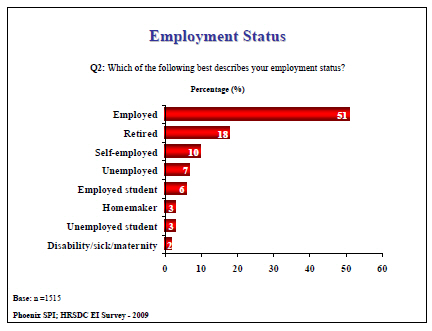
(Graph Description)
The above bar graph shows the employment status. The percentage value for each category is as follows:
Please note that the determination of respondents’ employment status for the purpose of analysis included responses to multiple questions.4
Type of Self-EmploymentOf respondents who identified themselves as self-employed (n = 168), relatively few (13%) said their employment was seasonal. A substantial minority (43%) said they had employees working for them.

(Graph Description)
The above bar graph shows the type of self-employment (if it is seasonal, or if it employs staff). The percentage value for each category of those responding ‘yes’ is as follows:
4 Please see Footnote 1 for definition of the terms “employed” and “self-employed” used elsewhere in this report.
Substantial Majority of Self-Employed Work Full-TimeOver three-quarters of self-employed respondents (80%) said they work full-time, while the rest do so part-time (20%).

(Graph Description)
The above pie chart shows the proportion of Full-time vs. Part-time self-employed. The percentage value for each portion is as follows:
Although indicating that they work part-time, 18% of respondents who identified themselves as self-employed also said that they work 35 or more hours per week. That said, given the very small sample size available for this group (n = 32) it is not possible to confidently identify the number of hours worked per week by part-time self-employed.
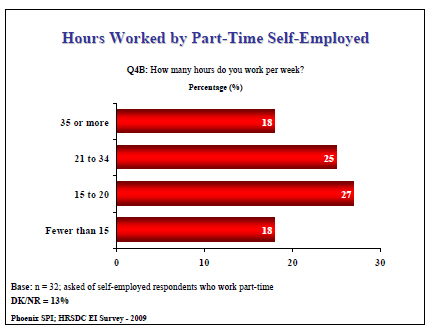
(Graph Description)
The above bar graph shows the hours worked per week by part-time self-employed. The percentage value for each category is as follows:
The large majority of self-employed respondents said they did not have another job apart from their self-employment (85%), while the rest said they did (15%).
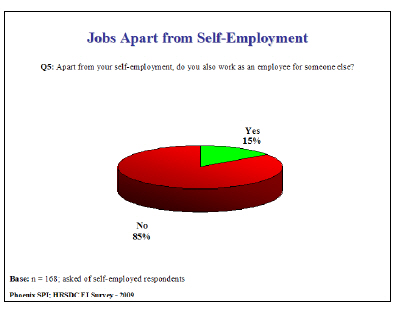
(Graph Description)
The above pie chart shows the jobs apart from self-employment. The percentage value for each portion is as follows:
The vast majority of employed respondents (including self-employed respondents who also work for an employer) were not seasonal workers (89%); only 11% percent said they were.
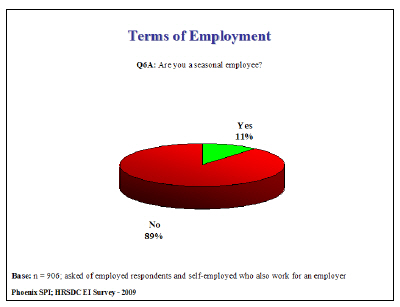
(Graph Description)
The above pie chart shows the proportion of employed respondents (including those self-employed who also work for an employer) whose employment is seasonal. The percentage value for each portion is as follows:
Nearly all employed respondents (94%) said their employer deducts EI and CPP amounts from their pay.
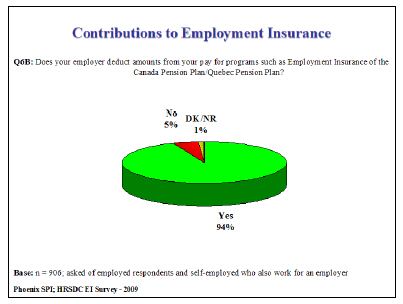
(Graph Description)
The above pie chart shows the proportion of employed respondents (including those self-employed who also work for an employer) who contribute to the EI program. The percentage value for each portion is as follows:
Seventy-three percent of employed respondents, excluding the self-employed who do not also work for an employer, said they were not responsible for managing other employees as part of their job. The other 27% said that they do have such responsibilities.
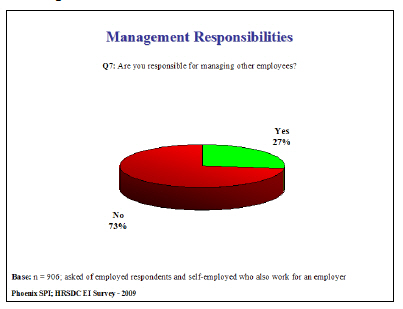
(Graph Description)
The above pie chart shows the proportion of employed respondents (including those self-employed who also work for an employer) with management responsibilities. The percentage value for each portion is as follows:
Just over three-quarters of employed respondents (78%) said they work 35 hours or more per week. Of the rest, 12% worked between 21 and 34 hours, and 9% worked less than this.

(Graph Description)
The above bar graph shows the hours worked per week by persons working for an employer (only). The percentage value for each category is as follows:
Over half of all unemployed respondents and homemakers (58%) said they are looking for work, while the other 42% indicated that they are not seeking employment.
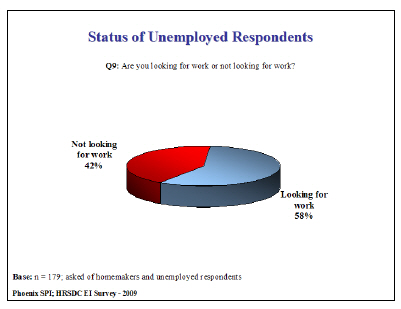
(Graph Description)
The above pie chart shows the status of unemployed respondents (including homemakers). The percentage value for each portion is as follows:
This section presents subgroup differences for key issues explored in this survey. This includes variations based on gender, language, age, education, region, rural-urban locations, status regarding receipt of EI, and employment status. In addition to these demographic variables, this section also presents relevant variations based on perceptions of the Canadian economy. For the analysis, characteristics have been grouped as follows:
Gender
Language:
Age:
Education:
Region
Rural-Urban Location
Receipt of EI
Employment Status
Perceptions of the Canadian economy
State of the Economy
Residents of B.C. were most likely to think the economy is weakening at all levels. They were most likely to think their local economy is weakening (72%), while residents of Quebec were least likely to think this (39%). Residents of B.C. were also most likely to think their provincial economy is weakening (83%), while residents of Atlantic Canada were least likely to think this (51%). Finally, residents of B.C. were most likely to think the Canadian economy as a whole is weakening (82%), while residents of Atlantic Canada were least likely to think this (73%). Residents of Atlantic Canada were most likely to think their provincial economy is stable (40%), while perceptions that the Canadian economy is stable were highest in the Prairies and Atlantic Canada (23% each).
Canadians 35 and older were most likely to think the economy is weakening locally (60% of 35-54 year olds and 55% of those 55 and older vs. 44% of those under 35), and provincially (76% of 35-54 year olds and 73% of those 55 and older vs. 63% of those under 35).
In addition,
Perceptions of the economy at all three levels were correlated in the sense that those who thought the economy is getting stronger, staying the same, or weakening at one level also had the same assessment of the economy at the other levels.
Likelihood of Job Loss
The following were most likely to be certain that they will not lose their job in the next year (i.e. that job loss is not at all likely):
Moreover, certainty about this decreases with age and increases with education.
On the other hand, Canadians who have received EI benefits in the last five years were more likely than those who have not to think it very likely that they will lose their job in the next year (10% vs. 4%).
Awareness & Perceptions of EI ProgramPrevious use of EI Benefits
The following were most likely to say they have received EI benefits during the past five years:
The likelihood of having received such benefits over the last five years also decreased with age (from 36% of those under 35 to 14% of those 55 and older).
The likelihood of saying that other members of the household received EI benefits in the last five years also decreased with age (from 29% of those under 35 to 10% of those 55 and older). Regionally, the likelihood of saying this was highest in Quebec (23%) and lowest in the Prairies (14%).
When it came to reasons for receiving EI benefits, the likelihood of citing job loss was highest among the unemployed (63% vs. 37% of the employed), Canadians with a high school education or less (57% vs. 39% of those with at least some post-secondary education), men (61% vs. 32% of women), and Anglophones (50% vs. 33% of Francophones).
Anglophones were more likely to cite maternity leave as a reason for receiving EI benefits than Francophones (20% vs. 11%). The likelihood of citing maternity leave also decreased with age (from 28% of those under 35, to 13% of those 35-54, to 2% of those 55 and older), but increased with education (from 6% of those with high school education or less to 32% of those with a university degree).
Illness was more likely to be cited by women as a reason for receiving such benefits (17% vs. 7% of men), while seasonal work was most likely to be cited by Canadians with a high school education or less (17% vs. 6% of those with at least some post-secondary education).
Confidence in Availability of EI
Among Canadians who work for an employer, those 35 and older were most likely to be very confident that they could access EI benefits if they were to lose their job (66% of 35-54 year olds and 71% of those 55 and older vs. 56% of those under 35). Francophones were more likely to be very confident about this than Anglophones (75% vs. 60%), as were residents of Quebec compared to residents of other regions (73% vs. 52-63% elsewhere). As well, the likelihood of being very confident about this increased with education (from 50% of those with a high school education or less to 73% of those with a university degree).
Those who think the Canadian economy is weakening were more likely than those who think it is stable to lack confidence in their ability to access EI (13% vs. 7%).
Perceived Abuse of EI Program by Seasonal Workers
Residents of rural areas were more likely than resident of urban areas to strongly agree that too many people stay in seasonal jobs because they are able to collect EI benefits (29% vs. 21%). As well, Canadians with a high school education or less were more likely to strongly agree with this than those with a university degree (25% vs.19%). Moreover, the likelihood of strong agreement with this decreased with education. Meanwhile, Canadians who have received EI benefits in the last five years were more likely than those who have not to strongly disagree with this (29% vs. 21%).
Perceived Fairness of EI Program
Canadians who have received EI benefits in the last five years were more likely than those who have not to think that the EI program is fair (55% vs. 43%). Canadians under 35 were also most likely to think this (56% vs. 47% of 35-54 year olds and 42% of those 55 and older), as were employed Canadians compared to self-employed Canadians (50% vs. 39%). Finally, those who think the Canadian economy is stable were more likely to think the EI program is fair than those who think the economy is weakening (55% vs. 45%).
Perceptions of Support Amounts
Canadians under 35 were most likely to describe the level of income support provided by the EI program as adequate (57% vs. 45% of 35-54 year olds and 46% of those 55 and older). Regionally, only in the Prairies did a majority think this (54% vs. 41-49% elsewhere). On the other hand, Canadians who have received EI in the last five years were more likely than those who have not to describe the level of income support as insufficient (45% vs. 37%).
Awareness of Extra Benefits for Low-Income Families
Awareness of additional EI benefits available to low-income families was highest among the following:
Perceptions of Need for Reforming EI Program
Canadians under 35 were most likely to think that the EI program works well enough as it is, and that only minor adjustments would be needed if problems were to arise (63% vs. 54% of 35-54 year olds and 48% of those 55 and older). Employed Canadians were also more likely to think this than unemployed Canadians (57% vs. 50%). Regionally, residents of the Prairies were most likely to think this (58%) while residents of B.C. were least likely to (48%).
On the other hand, perceptions that major reforms to the EI program are needed were highest among the following:
Of those who think that changes are required, employed Canadians were most likely to suggest increasing the amount of benefits paid (25% vs. 17% of those unemployed and 16% of those self-employed), and expanding eligibility/making it easier to claim benefits (17% vs. 11% of those unemployed and 9% of those self-employed). Canadians with a university degree were also most likely to suggest expanding eligibility/making it easier to claim benefits (20% vs. 13% of those with some post-secondary education and 9% of those with a high school education or less). Reducing the waiting period was most likely to be recommended by Canadians 35 and older (15% of 35-54 year olds and those 55 and older vs. 8% of those under 35), and Francophones (18% vs. 12% of Anglophones).
Preferred Approach to Distribution of Benefit Payments
The following were most likely to say they would like a choice in the manner in which they received their EI benefits:
Given a choice in how benefits would be paid, the following were most likely to say they would choose to receive a higher amount of EI benefits over fewer weeks:
Women were more likely than men to prefer receiving a lower amount of benefits over more weeks (44% vs. 37%).
Awareness of EI Sick Leave Benefits
The following were most likely to be at least somewhat aware of short-term illness leave available under the EI program:
Awareness of Compassionate Care Benefits
Canadians with a university degree were more likely to be at least somewhat aware of compassionate care benefits than Canadians with a high school education or less (52% vs. 44%). Moreover, the likelihood of being aware of this increased with education. Anglophones were also more likely to be aware of these benefits (54% vs. 28% of Francophones).
The following were most likely to be very aware of these benefits:
Residents of Quebec were most likely to be not at all aware of these benefits (51%).
Incidence of Situations Requiring Time Off Work for Compassionate Care
Anglophones were more likely to say they have been in a situation where their job demands were in direct conflict with the need to care for a gravely ill or dying person (15% vs. 8% of Francophones), a one-time medical emergency or injury (19% vs. 11% of Francophones), and someone with a chronic or long-term illness (16% vs. 9% of Francophones). Canadians 35 and older were most likely to have been in a situation where their job demands were in conflict with the need to care for a gravely ill or dying person (15% of 35-54 year olds and 19% of those 55 and older vs. 6% of those under 35), and for someone with a chronic or long-term illness (15% of 35-54 year olds and 17% of those 55 and older vs. 9% of those under 35).
Likelihood of Using Compassionate Care Benefits in Future
The following were most likely to say that should a situation arise in the future where they needed to take time away from work to care for a gravely ill family member, they would be very likely to take advantage of Compassionate Care benefits:
Canadians in all regions of the country except Quebec said they would be very likely to do this (57-61% vs. 46% in Quebec).
On the other hand, the following were most likely to say they were not at all likely to take advantage of Compassionate Care benefits: self-employed Canadian (20% vs. 6% of employed and 8% of unemployed Canadians), Canadians who have not received EI in the past five years (12% vs. 4% of those who have), and Canadians 55 and older compared to those under 35 (11% vs. 6%).
Interest of Self-Employed in BenefitsCaution should be exercised in interpreting these results because of the relatively limited number of self-employed respondents (n = 199). Moreover, because of the small number of self-employed respondents in each region, regional differences will not be reported.
Benefits in Case of Business Failure
Self-employed women were more likely than self-employed men to express at least moderate interest in a program that provided benefits in case of business failure similar to those provided by the EI program (85% vs. 65%). Anglophones were also more likely to express interest in this (78% vs. 61% of Francophones), as were Canadians under 55 (86% of those under 35 and 76% of 35-54 year olds vs. 61% of those 55 and older).
Sick Leave Benefits
Self-employed women were also more likely to express at least moderate interest in a program that provided up to 15 weeks of sick leave benefits if they became injured or too sick to work (94% vs. 80% of men). As well, self-employed Canadians who have received EI benefits in the last five years were more likely to express strong interest in this (76% vs. 59% of those who have not received EI benefits in the past five years).
Parental Benefits
Self-employed Canadians under 35 were most likely to express at least moderate interest in a program that provides up to 35 weeks of parental benefits (90% vs. 64% of 35-54 year olds and 51% of those 55 and older).
Compassionate Care Benefits
Canadians between 35 and 54 years of age were more likely than those 55 and older to express strong interest in compassionate care benefits (67% vs. 44%).
Program FinancingPerceptions of EI Premiums
Canadians most likely to think that EI premiums have gone up over the last five years included those 35 and older (34% of 35-54 year olds and 37% of those 55 and older vs. 23% of those under 35), and Francophones (37% vs. 31% of Anglophones). Regionally, residents of Quebec (37%) and the Prairies (35%) were most likely to think this, while residents of B.C. were least likely to (23%).
The perception that premiums have gone down was highest among Francophones (10% vs. 4% of Anglophones), and employed Canadians were more likely to think this than unemployed ones (7% vs. 3%).
The perception that premiums have not changed over the last five years was higher among Canadians who have received EI benefits over the past five years (37% vs. 30% of those who have not received EI benefits), and Anglophones (35% vs. 27% of Francophones). In addition, the likelihood of thinking that premiums have not changed decreased with age (from 43% of Canadians under 35 to 23% of those 55 and older). Regionally, residents of Ontario (38%) and Atlantic Canada (37%) were most likely to think this, while residents of Quebec were least likely to (27%).
New InitiativesAwareness of EI-Related Measures in February 2009 Budget
Definite awareness of the five week increase in the duration of EI benefits was highest among the following:
Definite awareness of the provision of $500 million to the EI program for training-related purposes was highest among the following:
Definite awareness of the measure to maintain EI premium rates for 2009-2010 was highest among Canadians 55 and older compared to those under 35 (12% vs. 7%) and Anglophones (12% vs. 7% of Francophones).
Differences in definite awareness of these three measures were evident regionally but followed no pattern.
Importance of Keeping Reserve in EI Account
The likelihood of considering it at least somewhat important to keep a reserve in the CEIFB did not vary much. However, Anglophones were more likely to consider this very important (62% vs. 50% of Francophones), as were Canadians with a university education compared to those with a high school education or less (62% vs. 54%). In addition, the likelihood of attributing the highest degree of importance to this increased with age (from 46% of those under 35 to 67% of those 55 and older). Regionally, residents of B.C. (68%) and Ontario (61%) were most likely to consider this very important while residents of Quebec were least likely to (51%).
Confidence that CEIFB will improve management of EI Program Financing
Canadians with a university education were more likely than those with a high school education or less to express at least moderate confidence that the new measures introduced by the Government of Canada will improve management of EI program financing (59% vs. 48%).
Other differences were evident at the extremes (i.e. the likelihood of expressing strong confidence or no confidence at all in these measures). Unemployed Canadians were more likely to be very confident about these new measures than employed Canadians (10% vs. 6%). At the other extreme, self-employed Canadians were more likely than employed ones to have no confidence at all in these measures (19% vs. 12%), as were men (15% vs. 11% of women) and Anglophones (14% vs. 9% of Francophones).This section presents the demographic characteristics of survey respondents, including gender, age, region, language, urban-rural location, income (household and personal), education, marital status, and whether there are children or others living in their household. The data were weighted by region, age and gender to reflect the actual distribution of Canadians (using Statistics Canada data). The first three graphs present both weighted and unweighted data, the rest present weighted data only.
Gender
Before weighting, the gender composition of the sample was an even split: 50% male (weighted to 49%) and 50% female (weighted to 51%).
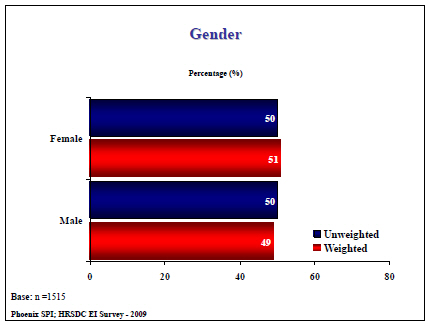
(Graph Description)
The above bar graph shows the gender breakdown. The percentage value for each category is as follows:
Overall, the sample’s age distribution approximated the actual population of Canada, with the exception of Canadians under 25 years of age (3% in sample vs. 11% in population). As noted, weights were applied to ensure correct proportions.
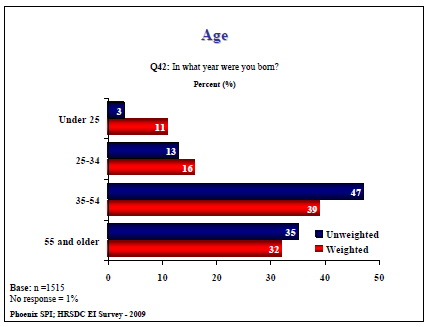
(Graph Description)
The above bar graph shows the age breakdown. The percentage value for each category is as follows:
In order to obtain better accuracy of findings for smaller provinces, the survey used a disproportionately stratified sample approach. As noted, weights were applied to bring the regional distribution in line with the population of Canada.

(Graph Description)
The above bar graph shows the region of residence. The percentage value for each category is as follows:
Twenty-three percent of respondents completed the survey in French.
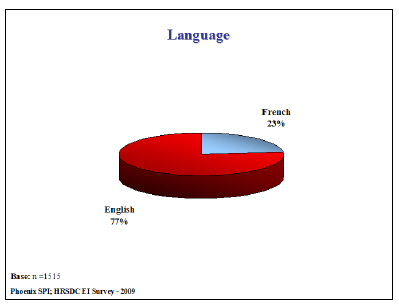
(Graph Description)
The above pie chart shows the language use. The percentage value for each portion is as follows:
The large majority of those surveyed were from urban areas (80%), while the remaining 20% were from rural regions.
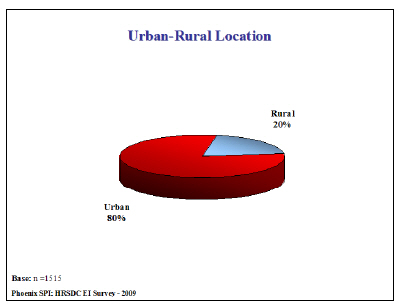
(Graph Description)
The above pie chart shows the urban-rural location. The percentage value for each portion is as follows:
When looking at the respondents’ 2008 household incomes, just over one-quarter (27%) earned less than $40,000, while another quarter (24%) made between $60,000 and $99,000. Fifteen percent made between $40,000 and $59,000, and one-fifth (21%) earned $100,000 or more. Thirteen percent chose not to provide an answer to this question.
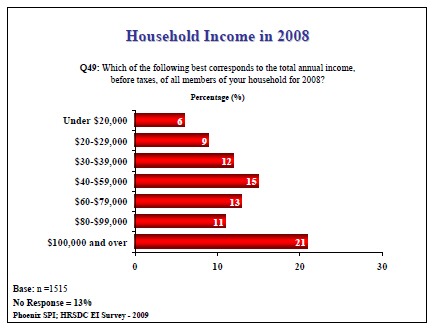
(Graph Description)
The above bar graph shows the household income in 2008. The percentage value for each category is as follows:
When it came to respondents’ 2008 personal incomes, half earned less than $40,000. Seventeen percent made between $40,000 and $59,000, and one-fifth earned $60,000 or more. Thirteen percent chose not to provide an answer to this question.
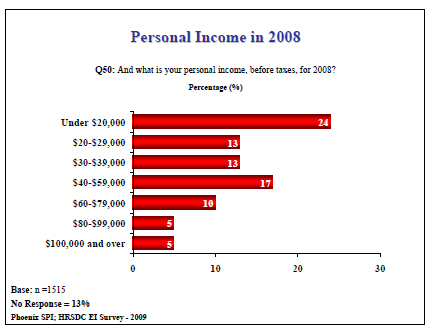
(Graph Description)
The above bar graph shows the personal income in 2008. The percentage value for each category is as follows:
A majority of those surveyed (55%) completed some form of post-secondary education. Conversely, 21% completed high school, while 9% had less than a high school education. Fifteen percent had enrolled in, but had not completed a college (8%) or university program (7%).
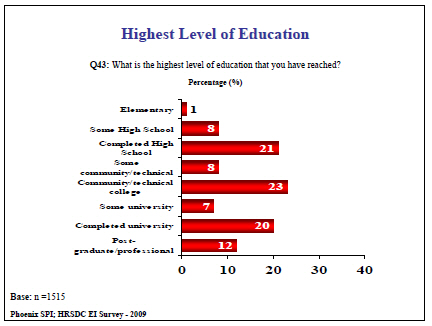
(Graph Description)
The above bar graph shows the highest level of education. The percentage value for each category is as follows:
Almost two-thirds of those surveyed were married or living as a couple (64%), while 23% said they were single. Of the rest, 6% were divorced, 4% were widowed, and 2% were separated from their spouse.

(Graph Description)
The above bar graph shows the marital status. The percentage value for each category is as follows:
Just over one-third of survey respondents (35%) had children under the age of 18 living in their household, while 65% did not.
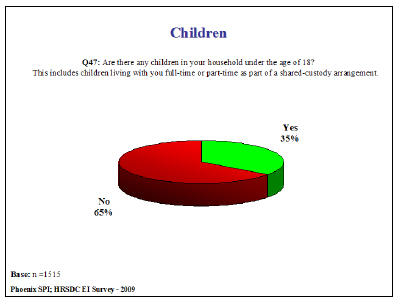
(Graph Description)
The above pie chart shows the incidence of children in the household under the age of 18. The percentage value for each portion is as follows:
The vast majority of respondents (90%) said they did not have any relatives over the age of 65 living in their household, while one in ten indicated that they did.
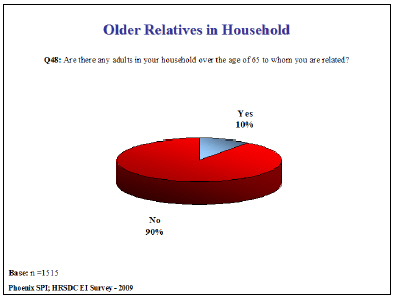
(Graph Description)
The above pie chart shows the incidence of older relatives in the household (over the age of 65). The percentage value for each portion is as follows:
Hello, my name is _____. I’m calling on behalf of Phoenix, a public opinion research firm. We’re conducting a survey for the Government of Canada to explore the attitudes of Canadians concerning Employment Insurance or EI**. The survey is registered with the national survey registration system.
A. We choose telephone numbers at random, then select one person from a household to be interviewed. May I please speak to the person in the household, 18 years of age or older, who has had the most recent birthday? Would that be you? (IF NOT, ASK TO SPEAK TO THAT PERSON AND START AGAIN)
IF NOT AVAILABLE NOW, ASK:
B. When would it be more convenient for me to call back?
Schedule callback if possible (time/day): ______________
C. Do you or does anyone in your household work for any of the following types of organizations: an advertising or market research firm, the media, or an elected official?
D. All responses will be kept confidential. No individuals or companies will be identified in any way. Would you be willing to take part in this survey? We can do it now, or is there a better time?
If respondent appears confused about this program, or asks for clarification, please say that Employment Insurance was previously called Unemployment Insurance or UI.
INTERVIEWER NOTES:
SURVEY LENGTH: IF RESPONDENT ASKS ABOUT THE LENGTH OF THE SURVEY, INFORM HIM/HER THAT IT AVERAGES 15 MINUTES, SOMETIME LESS. THE LENGTH VARIES DEPENDING ON RESPONSES TO SOME OF THE QUESTIONS.
RESEARCH VALIDITY: IF RESPONDENT QUESTIONS THE VALIDITY OF THE RESEARCH, INVITE HIM/HER TO: 1) CALL THE NATIONAL SURVEY REGISTRATION SYSTEM, OR 2) DEANNA JAMIESON OF THE GOVERNMENT OF CANADA 1-819-994-2710 OR HAVE DEANNA CALL THE RESPONDENT.
SURVEY REGISTRATION SYSTEM: IF RESPONDENT ASKS ABOUT NATIONAL SURVEY REGISTRATION SYSTEM, SAY:
The registration system has been created by the survey research industry to allow the public to verify that a survey is legitimate, get information about the survey industry or register a complaint. The registration system’s toll-free phone number is 1-800-554-9996.
PRIVACY: PARTICIPANTS’ COMMENTS WILL BE PROTECTED IN ACCORDANCE WITH THE PROVISIONS OF THE PRIVACY ACT. INDICATE THIS IF RELEVANT. ALSO SAY IF RELEVANT: “YOUR REPONSES TO THIS SURVEY WILL HAVE NO IMPACT ON YOUR DEALINGS WITH THE FEDERAL GOVERNMENT.”
HEADINGS IN BLUE SHOULD NOT BE READ TO RESPONDENTS.
UNLESS OTHERWISE SPECIFIED, ALL QUESTIONS IN THE SURVEY WILL ALLOW FOR ‘DON’T KNOW/NO RESPONSE’ OPTION. DK/NR IS ONLY SPECIFIED WHERE IT RELATES TO SKIP LOGIC.
A. Economic Perceptions1. In your opinion, is… (INSERT FROM BELOW) getting stronger, weaker, or is it staying about the same? (READ/RANDOMIZE LIST)
2. Which of the following best describes your employment status? Are you …? [READ LIST; ACCEPT ONE RESPONSE]
ASK SELF-EMPLOYED ONLY:
3. a) Is your self-employment seasonal?
b) Do you have employees?
4. a) Is your self-employment full-time or part-time?
b) How many hours do you work per week?
Record hours: _________
5. Apart from your self-employment, do you also work as an employee for someone else?
6. a) Are you a seasonal employee?
b) Does your employer deduct amounts from your pay for programs such as Employment Insurance or the Canada Pension Plan/Quebec Pension Plan*?
*USE QUEBEC PENSION PLAN IN QUEBEC AND CANADA PENSION PLAN IN ALL OTHER LOCATIONS.
7. Are you responsible for managing other employees?
8. How many hours do you work per week? [ SKIP IF RESPONDENT ASKED Q.4b ]
Record hours: ________________
ASK ALL ‘UNEMPLOYED’ AND ‘HOMEMAKERS’:
9. Are you …? [READ; ACCEPT ONE RESPONSE]
ASK ‘EMPLOYED’:
10. a) Is it very, somewhat, not very or not at all likely that you will lose your job in the next year?
10 b) If you were to lose your job in the next year, do you think it might be in the next…? (READ LIST. ACCEPT ONE RESPONSE)
11. If you did lose your job, would you be very, somewhat, not very or not at all likely to do each of the following? READ/DO NOT ROTATE LIST
12. On a scale from 1 to 7, where 1 means strongly disagree, 4 is neutral and 7 means strongly agree, how much do you agree or disagree with the following statement(s)* about the Employment Insurance Program? [READ AND ROTATE. MAKE PLURAL FOR EMPLOYED RESPONDENTS]
13. a) Do you think that the Employment Insurance Program is (ROTATE) fair, unfair or neither? [PROBE FOR VERY OR SOMEWHAT]
ASK THOSE WHO SAID ‘SOMEWHAT/VERY UNFAIR’:
13 b) What do you find most unfair about the Employment Insurance program? [DO NOT READ; ACCEPT ONE RESPONSE]
14. From what you know, do you think the level of income support provided by the Employment Insurance Program is generous, adequate or insufficient?
15. Are you very, somewhat, not very or not at all aware that the Employment Insurance Program provides additional benefits to low-income families who have children?
16. a) Some people say that [ROTATE] basically, the current Employment Insurance program works well and only minor adjustments should be made as needs arise. Other people say that [ROTATE] the current Employment Insurance program is not working well and requires major reforms over the next few years. Which view is closer to your own?
b) What adjustments or changes would you make? [DO NOT READ; ACCEPT ALL THAT APPLY]
17. The Employment Insurance Program currently provides for benefits of 55% of a worker’s average weekly earnings up to a maximum $447 per week. If you were to lose your job, would you prefer to have a choice in terms of how your benefits were paid… for instance, receiving a higher amount of EI benefits over fewer weeks or a lower amount of benefits over more weeks? Would you like to be offered a choice?
18. If you were to lose your job and had a choice in how your benefits were paid, which would you choose… receiving a higher amount of EI benefits over fewer weeks or a lower amount of benefits over more weeks?
ASK ‘EMPLOYED’:
19. Are you very, somewhat, not very or not at all aware that eligible workers who have a short-term illness can receive up to 15 weeks of EI sickness benefits?
20. Are you very, somewhat, not very or not at all aware that eligible workers can receive some income benefits to take time off work to care for or support a gravely ill or dying family member?
21. Have you ever been in a situation where your job demands were in direct conflict with the need to provide care or support for any of the following… ? [READ/ROTATE]
a) A gravely ill or dying person?
b) Someone with a one-time medical emergency or injury?
c) Someone with a chronic or long term illness?
IF YES IN Q.21a CONTINUE; OTHERS GO TO Q.27
22. In order to care for the gravely ill or dying person, did you take time off work?
23. Since you did not take time off work, how was that person cared for? Would you say …? [READ LIST; ACCEPT ALL THAT APPLY]
IF YES IN Q.22 CONTINUE / OTHERS GO TO Q.27
24. How much time off work did you take to care for this person? Was it …? [READ LIST; ACCEPT ONE RESPONSE]
25. When you took time off work to care for this person did you do any of the following? [READ LIST; ACCEPT ALL THAT APPLY]
ASK IF RESPONDENT DOES NOT MENTION Q.25 CODE 6:
26. Why did you not use the Compassionate Care benefits? [DO NOT READ; ACCEPT ALL THAT APPLY]
Since January, 2004, the Government of Canada has been providing Compassionate Care Benefits to eligible workers under the Employment Insurance Program. This allows Canadians to take a temporary leave of absence from work to provide care or support to a gravely ill family member facing a significant risk of death within 6 months. The 6 weeks of benefits can be shared among family members and can be taken consecutively, concurrently or one week at a time by family members over a 26-week period.
27. In the future, if you were working and you were faced with a situation where you needed to take time away from work to care for or support a gravely ill family member, would you be very, somewhat, not very or not at all likely to apply for the Compassionate Care Benefits?
IF NOT VERY LIKELY OR NOT AT ALL LIKELY, ASK:
28. What would be the main reason you would not apply? [DO NOT READ; ACCEPT ONE RESPONSE]
Since January, 2004, the Government of Canada has been providing Compassionate Care Benefits to eligible workers under the Employment Insurance Program. This allows Canadians to take a temporary leave of absence from work to provide care or support to a gravely ill family member facing a significant risk of death within 6 months. The 6 weeks of benefits can be shared among family members and can be taken consecutively, concurrently or one week at a time by family members over a 26-week period.
27. In the future, if you were working and you were faced with a situation where you needed to take time away from work to care for or support a gravely ill family member, would you be very, somewhat, not very or not at all likely to apply for the Compassionate Care Benefits?
IF NOT VERY LIKELY OR NOT AT ALL LIKELY, ASK:
28. What would be the main reason you would not apply? [DO NOT READ; ACCEPT ONE RESPONSE]
ASK SELF-EMPLOYED*
The next few questions are for people like you who are self-employed.
29. a) Would you be very, somewhat, not very or not at all interested in a program that provided the following …? [READ/DO NOT ROTATE; HAVE RESPONDENT RATE EACH ITEM]
* DO NOT ASK 29 iii) or iv) IN QUEBEC
FOR EACH ITEM IN Q29a THAT RESPONDENT SAYS ‘VERY/SOMEWHAT INTERESTED, ASK:
b) Would you be willing to pay Employment Insurance premiums for… (benefits in case of business failure, maternity benefits, parental benefits, sickness benefits, and compassionate care benefits)?
30. If access was available to a package of maternity, parental, sickness, and compassionate care benefits for the self-employed, would you be willing to pay premiums equivalent to those which allow employees to collect these benefits?
31. If Employment Insurance maternity, parental, sickness, and compassionate care benefits were available for the self employed, how much time could you afford to take away from your work? [READ LIST; ACCEPT ONE RESPONSE]
32. To the best of your knowledge, have the Employment Insurance premiums that Canadians pay generally gone up, gone down or stayed the same over the past five years?
In 2008, the Government of Canada created a new Crown Corporation, the Canada Employment Insurance Financing Board (CEIFB). This organization will manage a bank account called a reserve where any excess premiums from a given year will be held and invested until they are used in subsequent years for Employment Insurance purposes. It will also be responsible for implementing a new mechanism to determine the premium rate for Employment Insurance.
33. Were you aware of this new initiative? (READ LIST)
34. In your opinion, how important is it that the federal government makes provisions to keep a reserve in the CEIFB?* Is it…?
*NOTE: REPEAT, IF NEEDED, THAT CEIFB STANDS FOR THE CANADA EMPLOYMENT INSURANCE FINANCING BOARD
35. How confident are you that these new measures will improve the management of the Employment Insurance program financing? (READ LIST)
36. The government is also taking steps to enhance Employment Insurance and provide additional funding for skills development and training. To what extent were you aware of the following measures undertaken by the government through the February 2009 Budget? How about the measure to… (READ/ROTATE A-C)? Were you aware of this? (READ LIST)
37. How many times have you received Employment Insurance benefits in the last five years?
38. Why did you receive Employment Insurance benefits? Was it …? [READ LIST; ACCEPT MULTIPLE RESPONSES]
39. While receiving Employment Insurance benefits during the last five years, did you move to find work?
ASK ALL:
40. Has anyone else in your household received Employment Insurance benefits in the last five years?
41. Why did this other person receive Employment Insurance benefits? Was it …? [READ LIST; ACCEPT MULTIPLE RESPONSES]
Now, I would like to get some information to help us group your answers with others that we will receive in this survey.
42. In what year were you born?
Record year: ____________
43. What is the highest level of education that you have reached? [DO NOT READ; ACCEPT ONE RESPONSE]
*NOTE: INCLUDES LEGAL, MEDICAL, ACCOUNTING AND SIMILAR OCCUPATIONS.
ASK EMPLOYED AND SELF-EMPLOYED:
44. In what industry do you work? [DO NOT READ; ACCEPT ONE RESPONSE]
45. Do you work for a small (<50 employees), medium (50-500) or large (500+) firm or organization?
ASK ALL:
46. Are you …? [READ LIST; ACCEPT ONE RESPONSE]
47. Are there any children in your household under the age of 18? This includes children living with you full-time or part-time as part of a shared-custody arrangement. [READ LIST; ACCEPT ONE RESPONSE]
48. Are there any adults in your household over the age of 65 to whom you are related? [READ LIST; ACCEPT ONE RESPONSE]
49. Which of the following best corresponds to the total annual income, before taxes, of all members of your household for 2008? Please stop me once your category is reached. [READ LIST; ACCEPT ONE RESPONSE]
50. And what is your personal income, before taxes, for 2008? Please stop me once your category is reached. Is it…? [READ LIST; ACCEPT ONE RESPONSE]
51. For verification purposes, what are the first three digits of your postal code? ________
That concludes the survey. Thank you very much for your thoughtful feedback. It is much appreciated.
Record by Observation/Call Records: